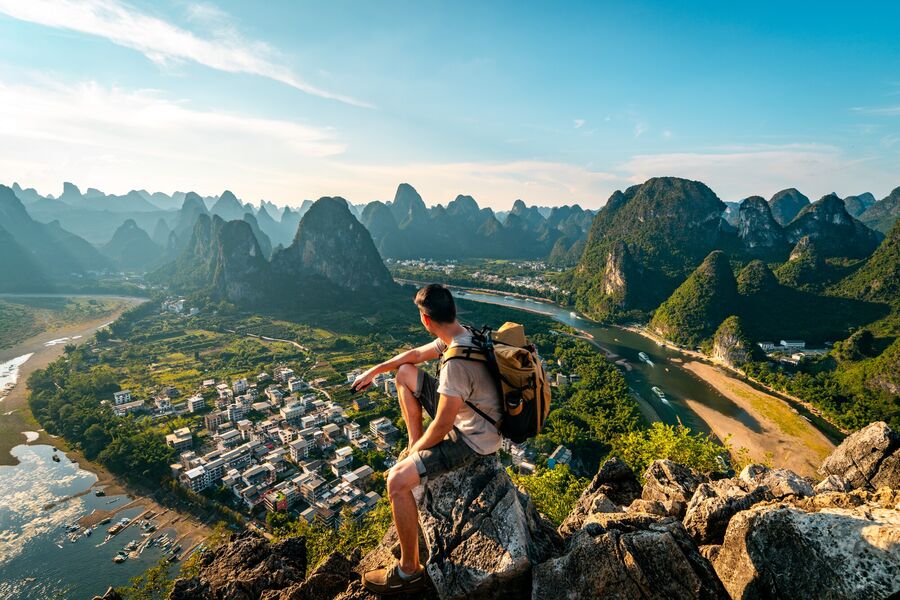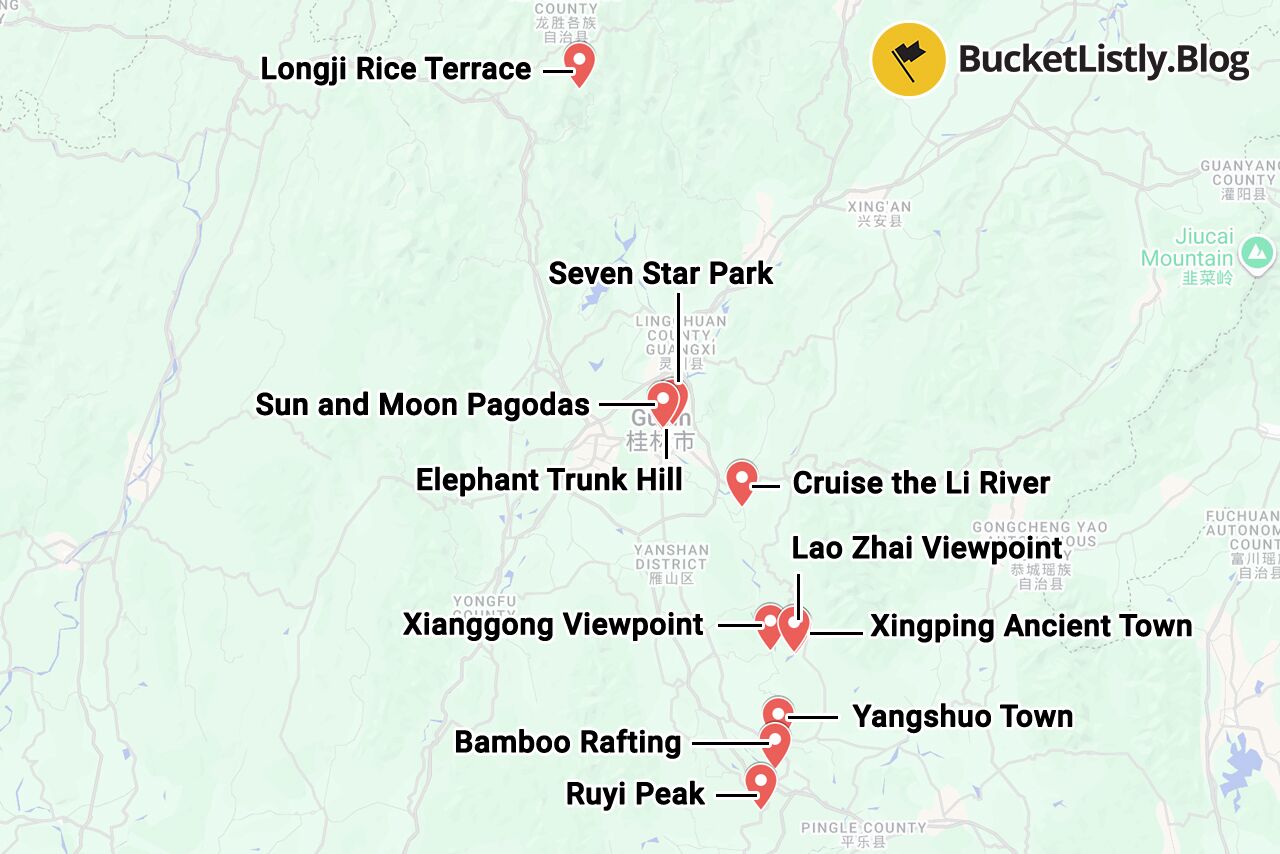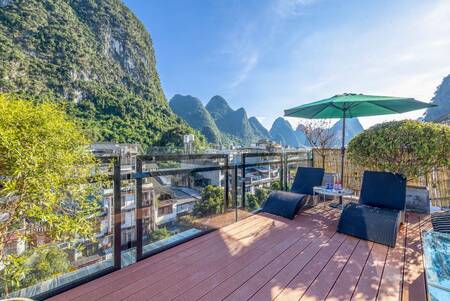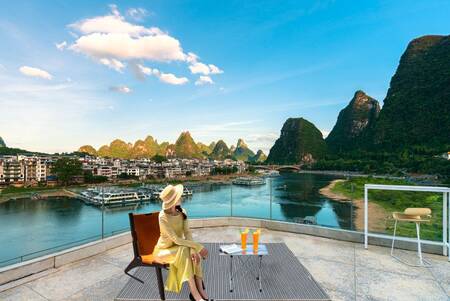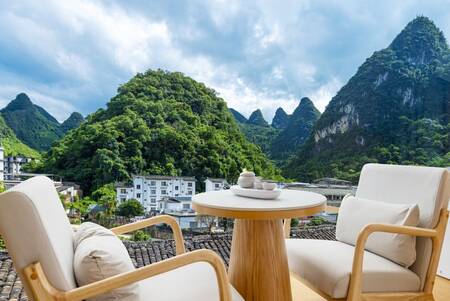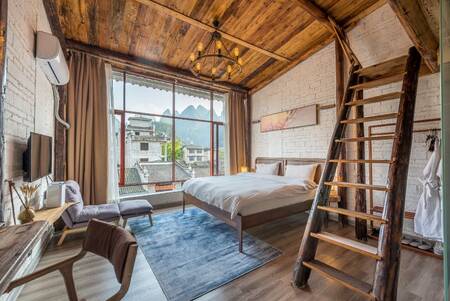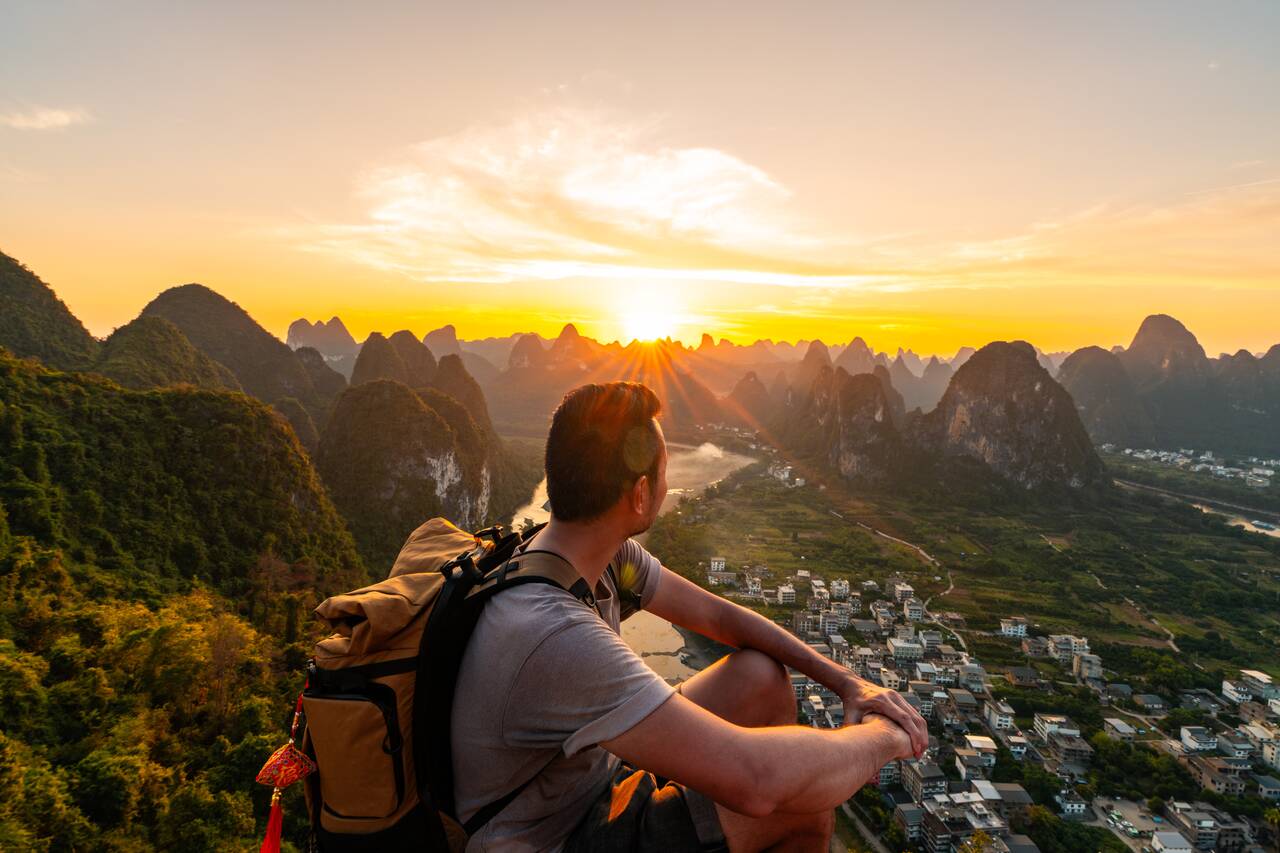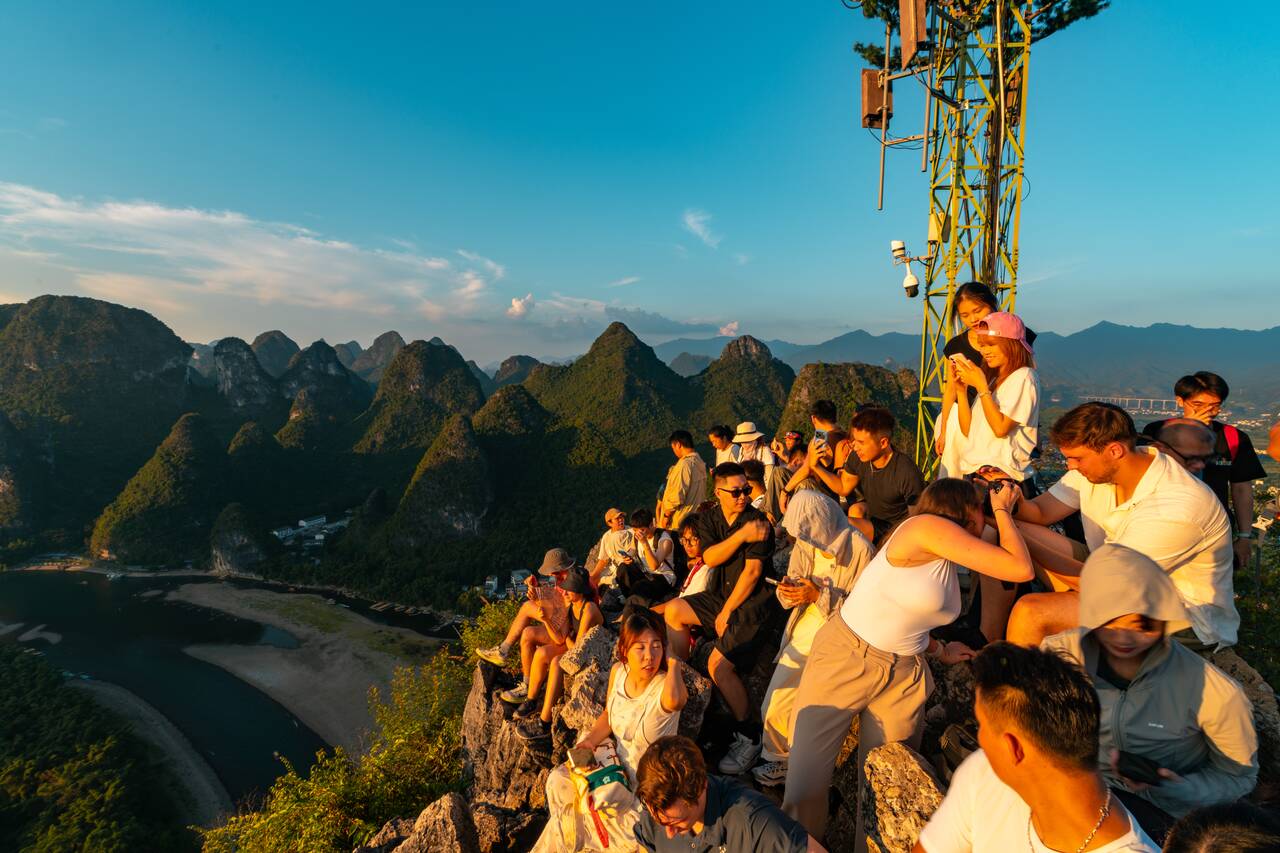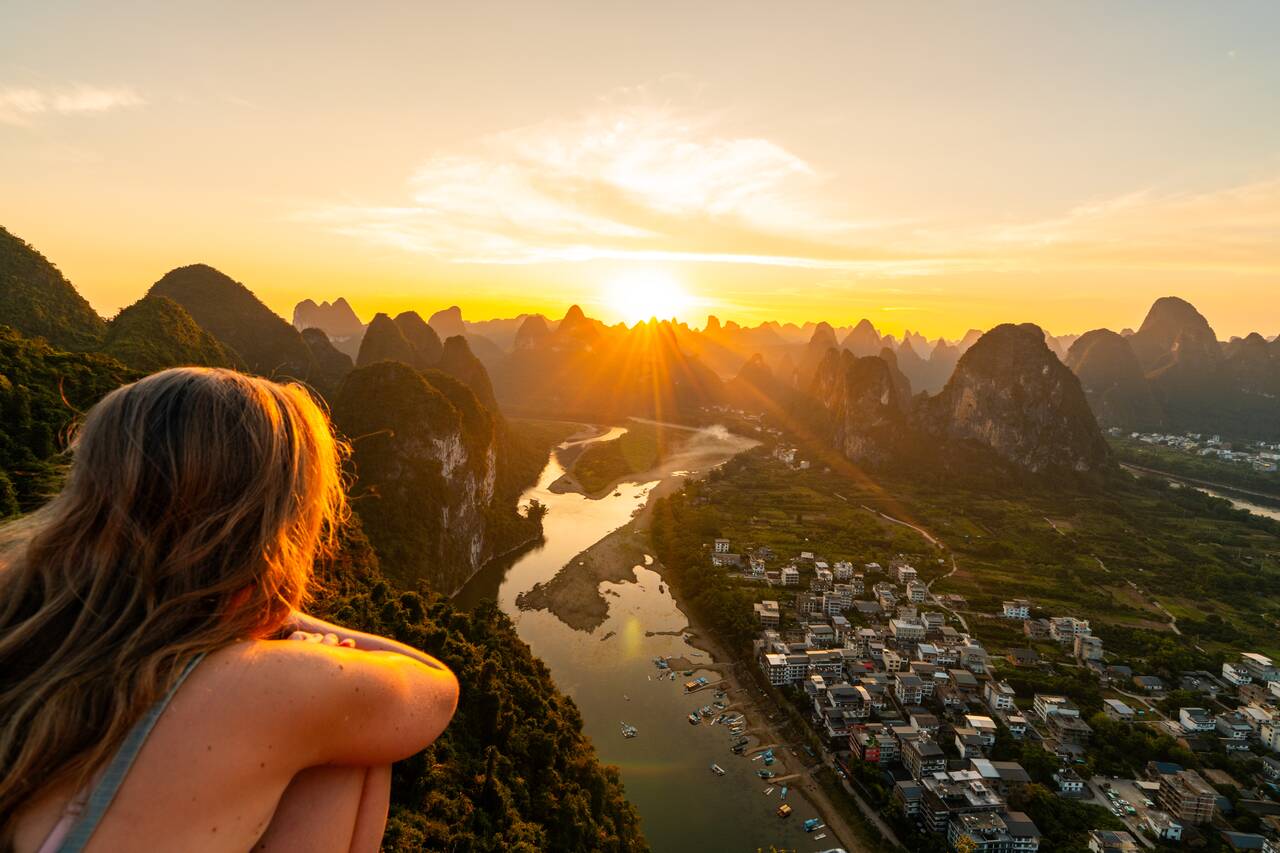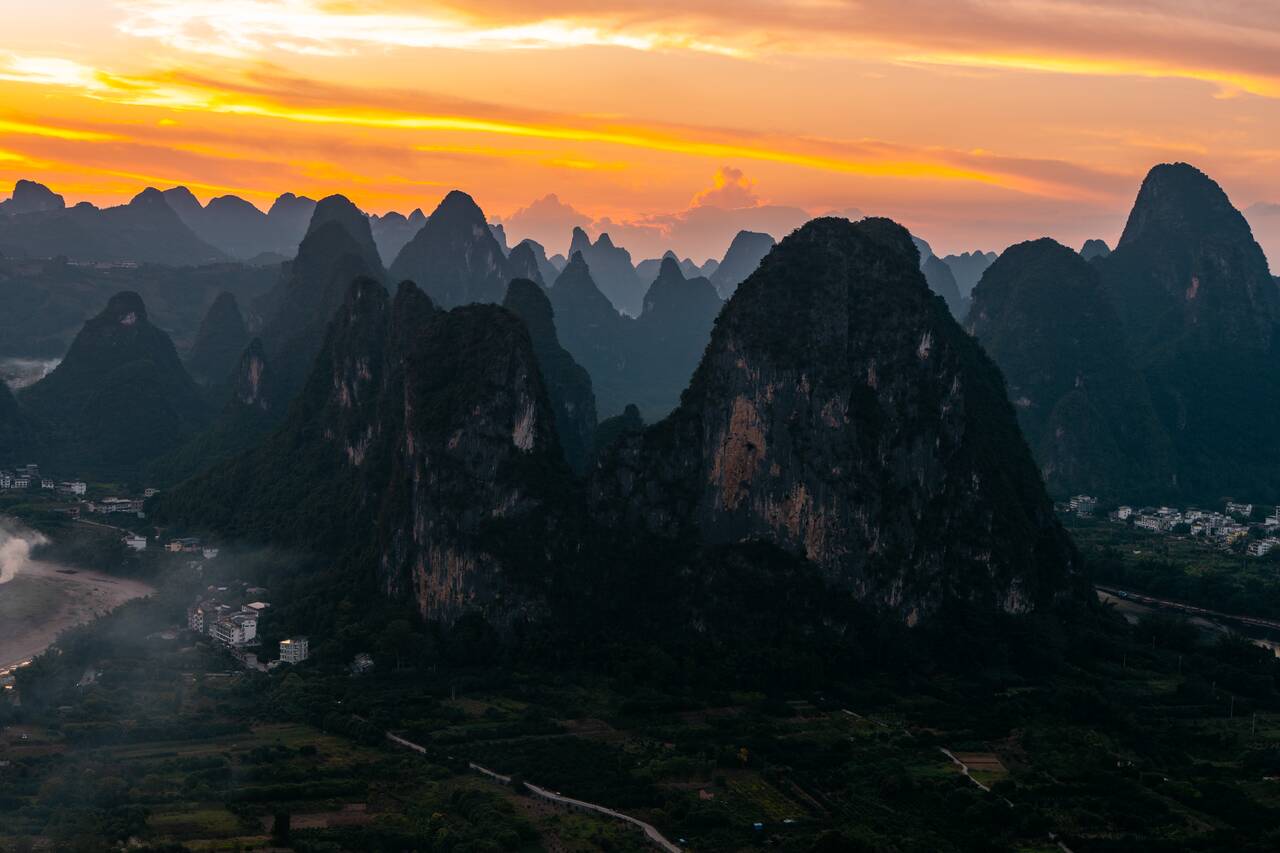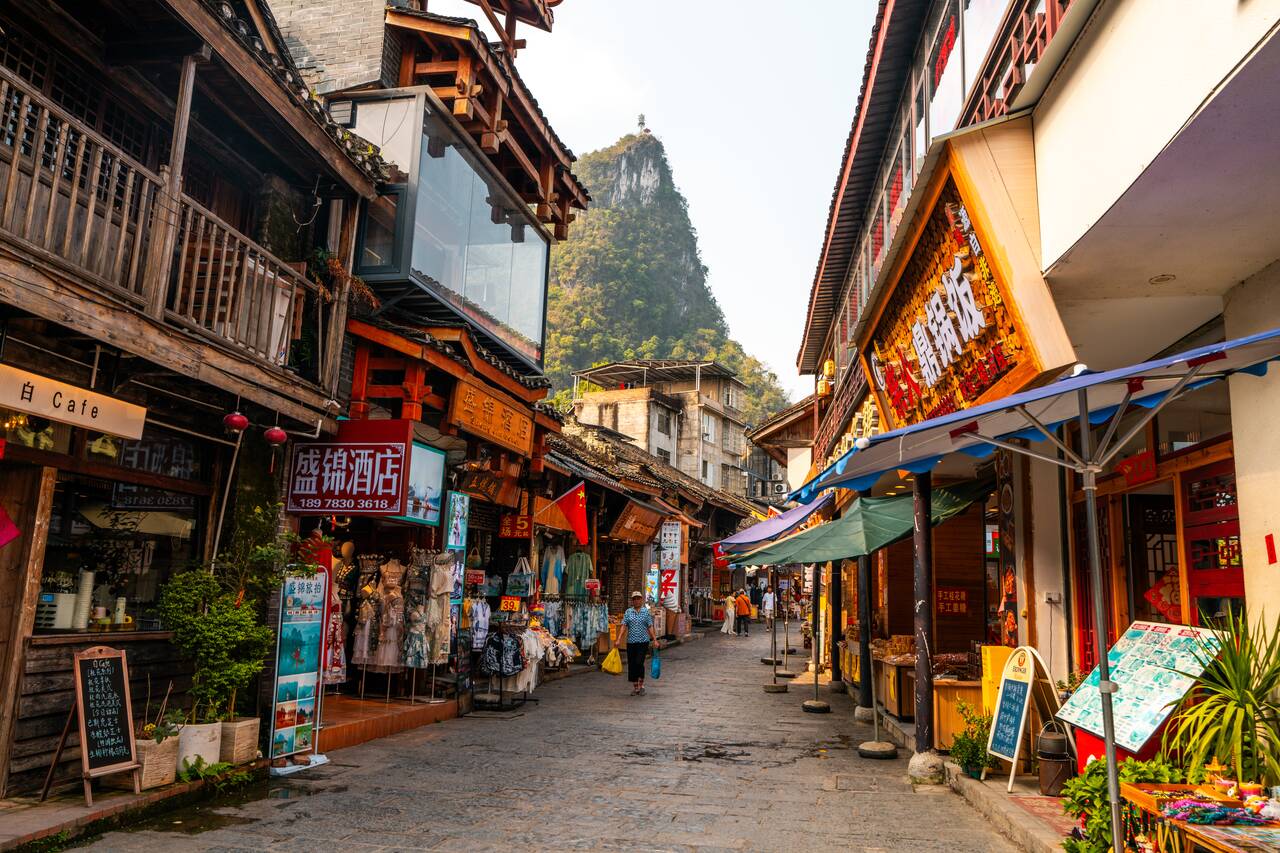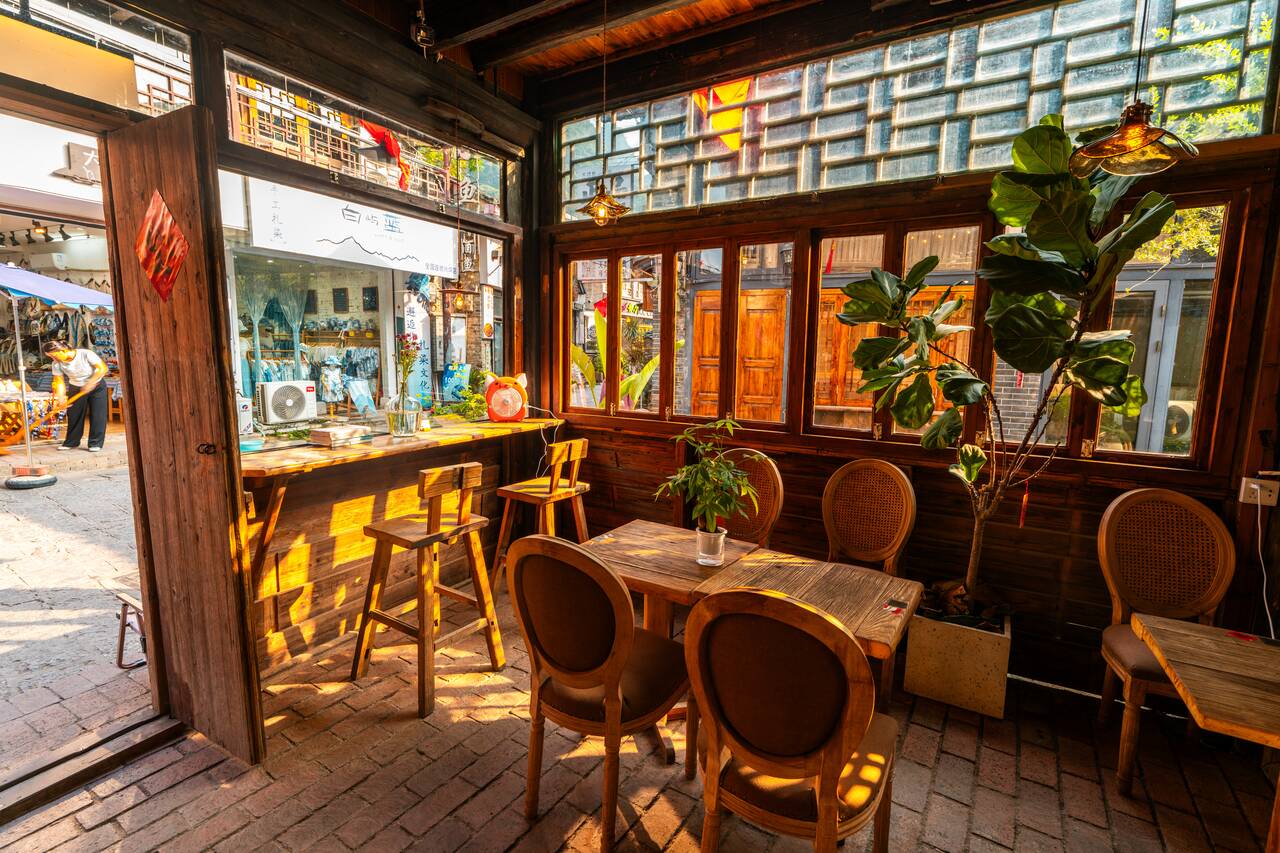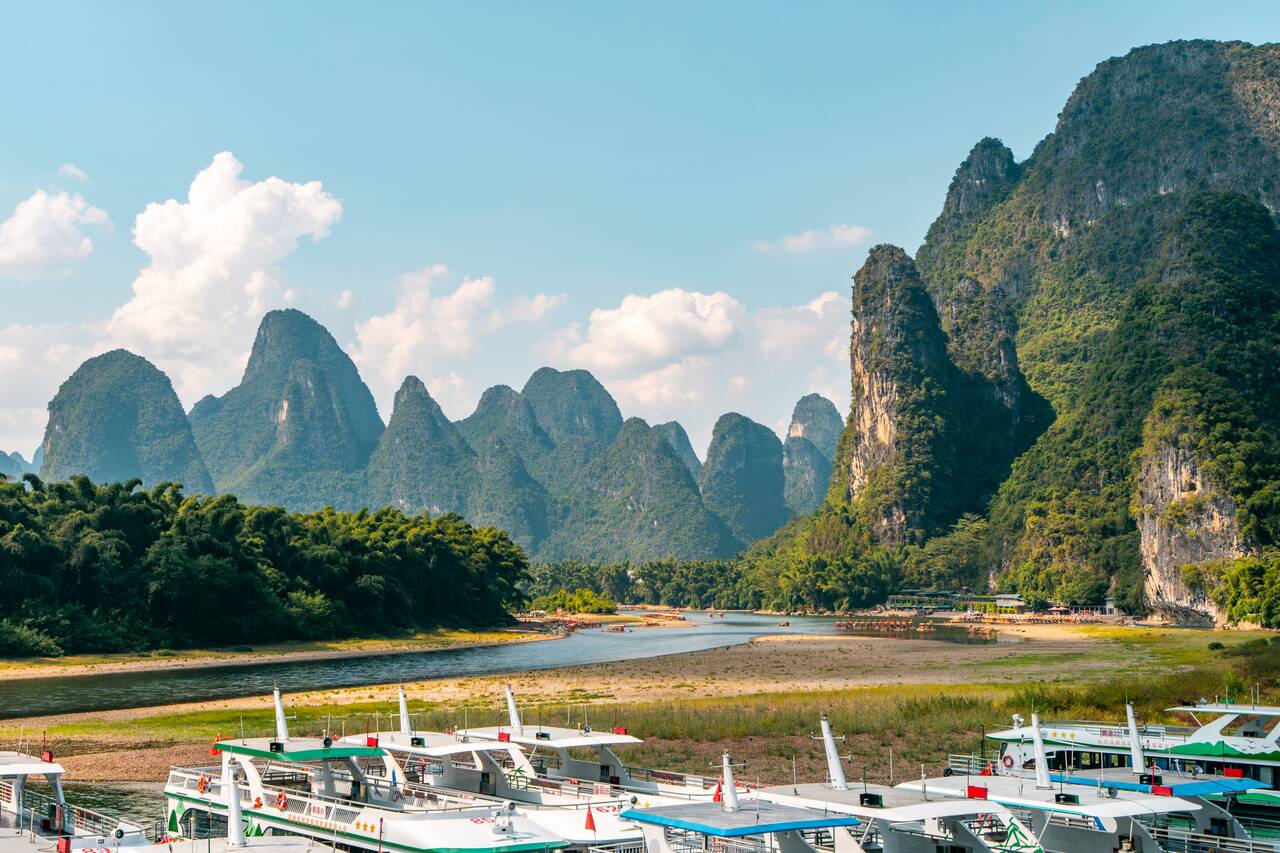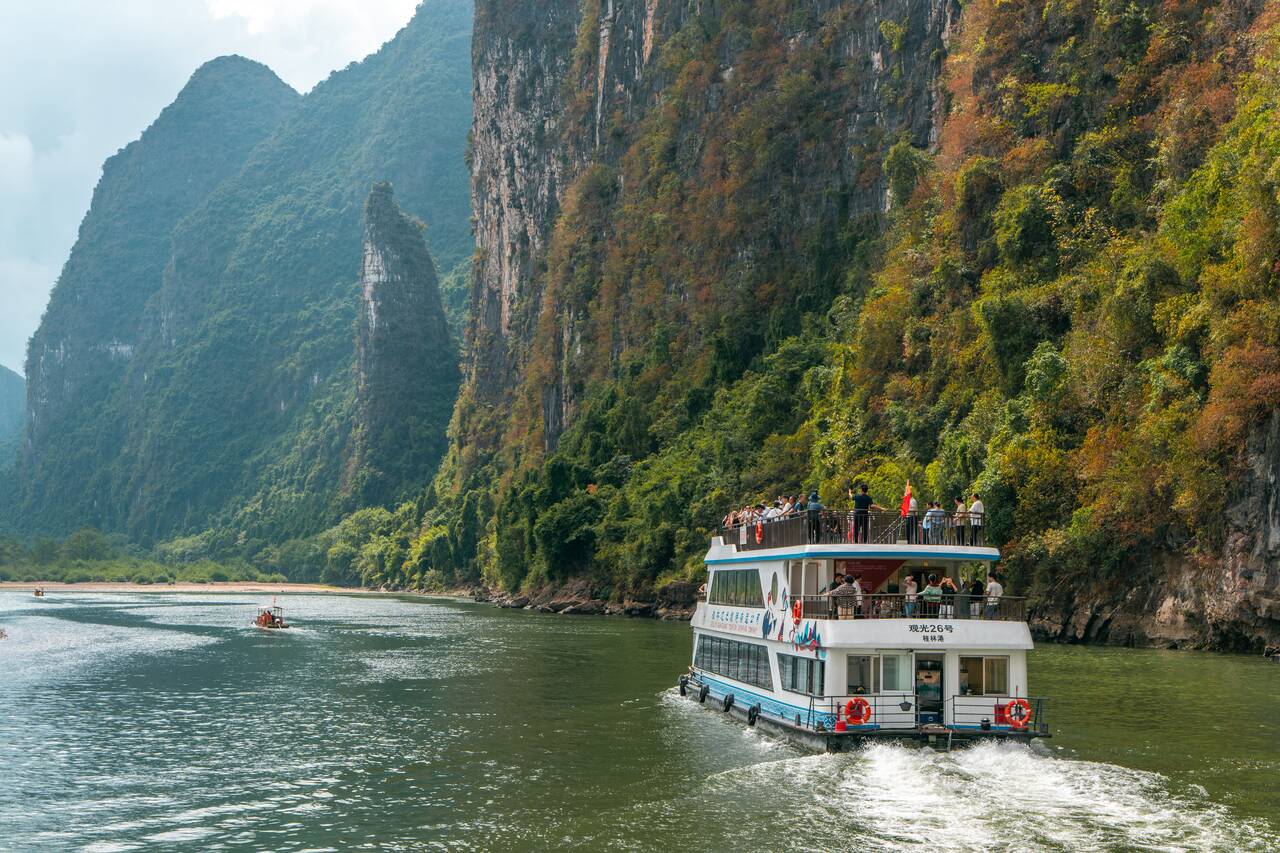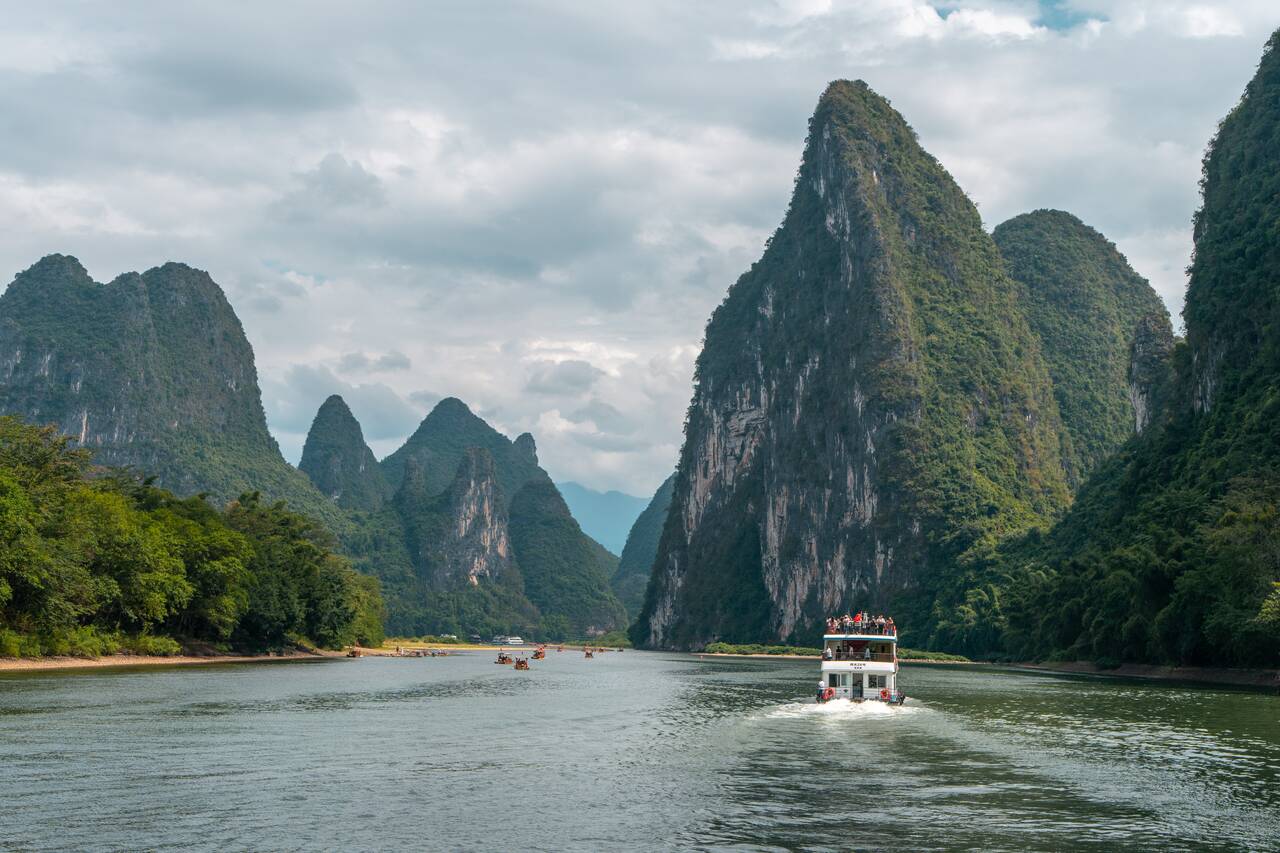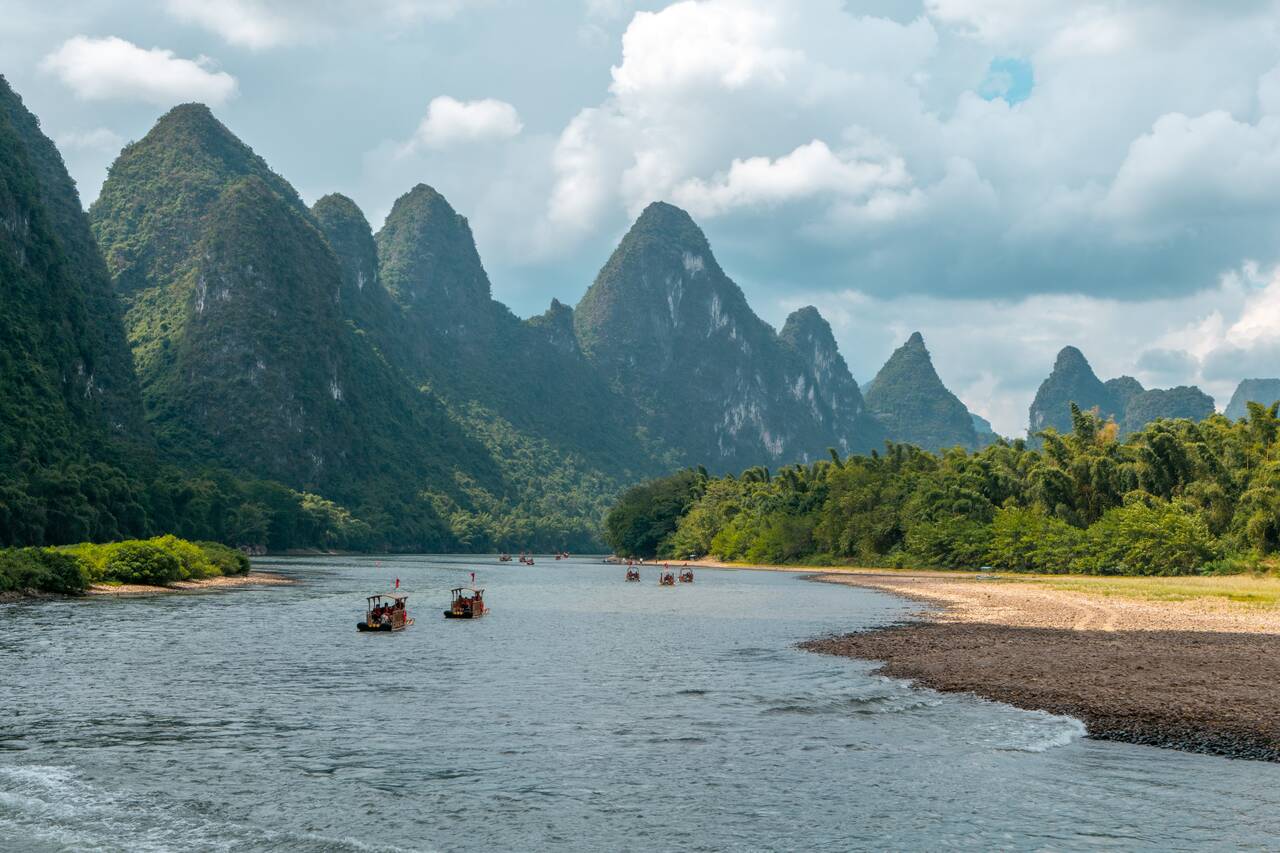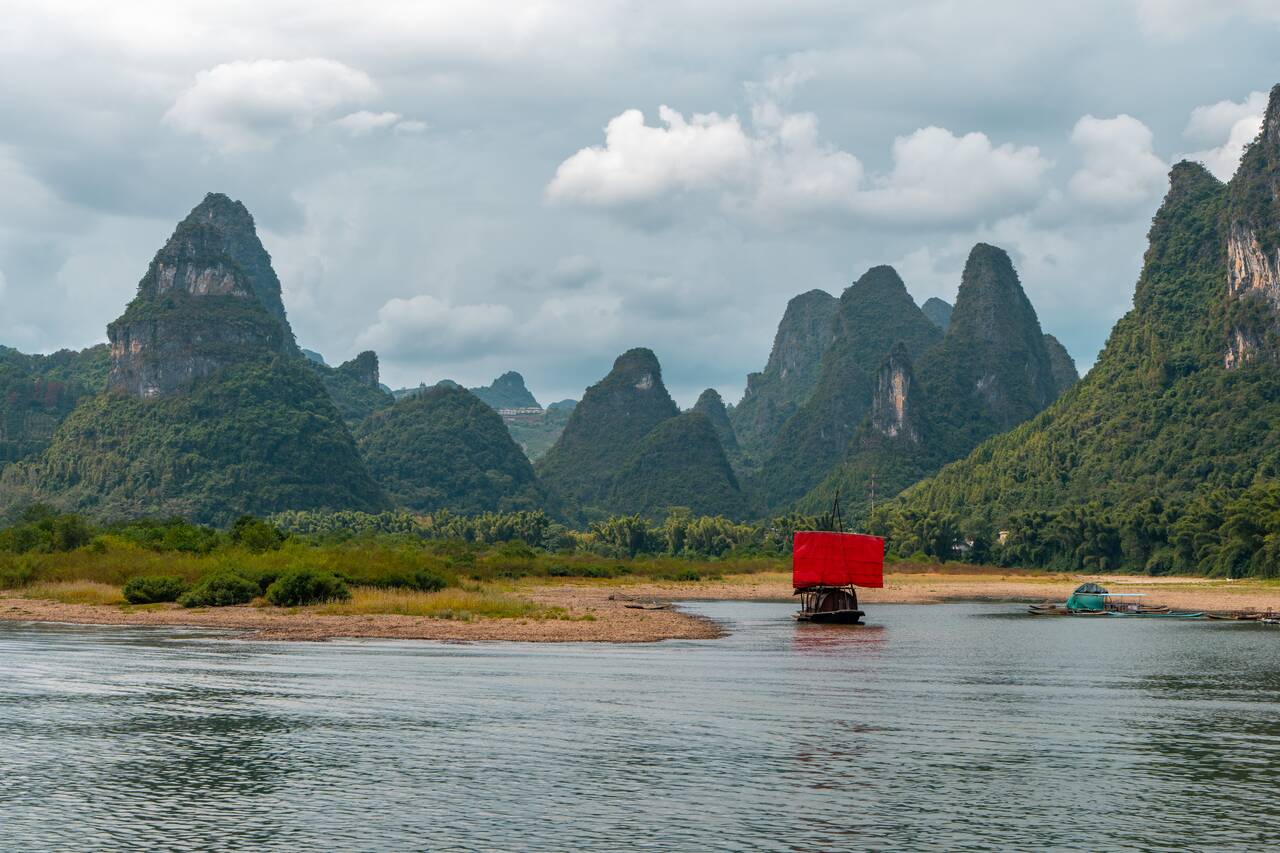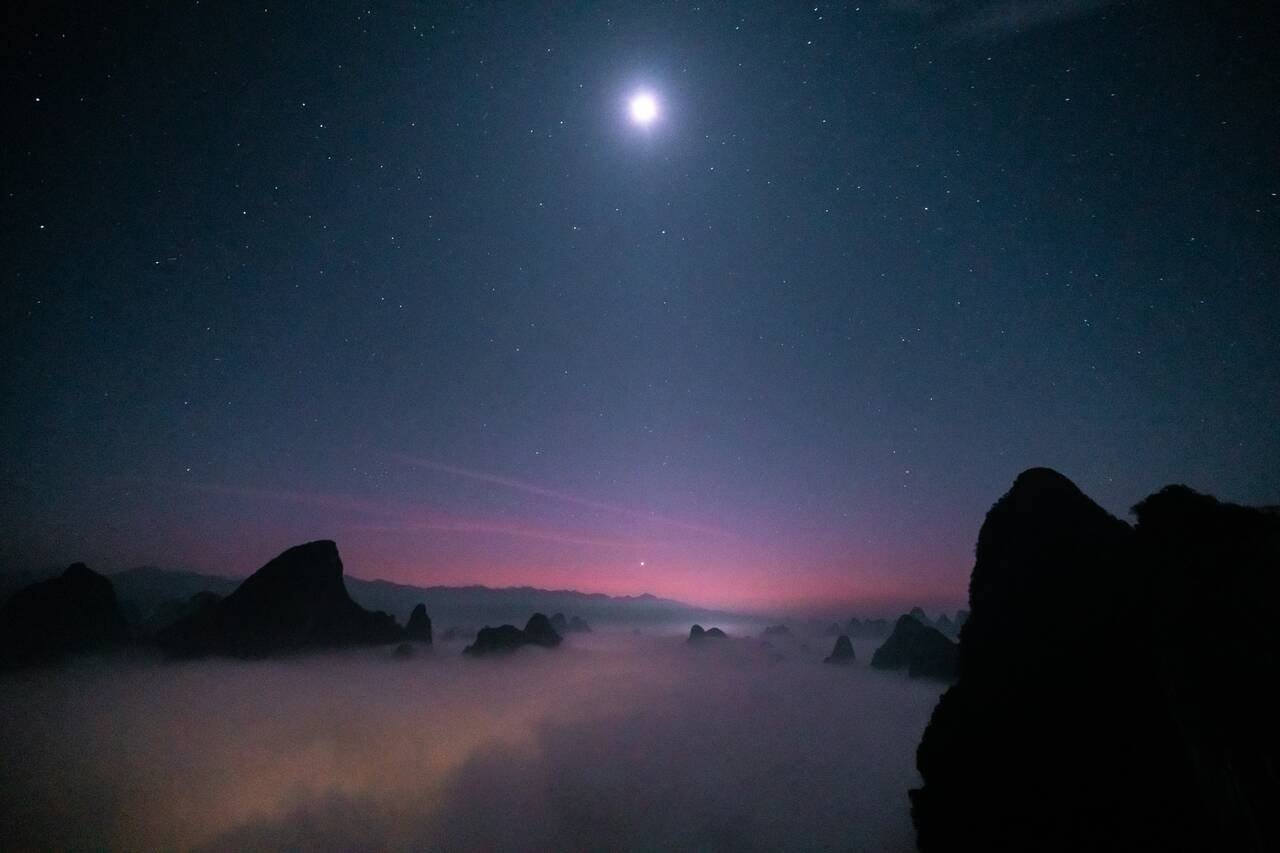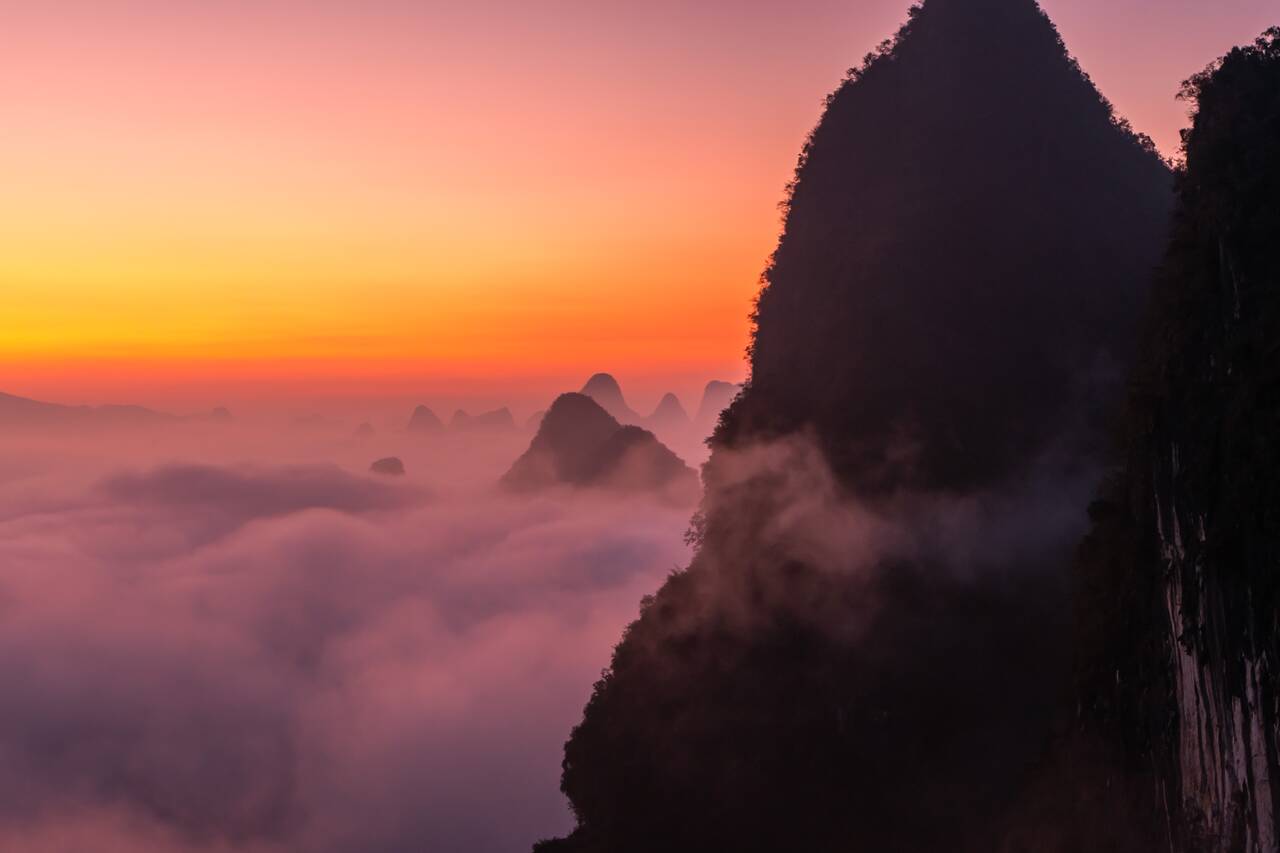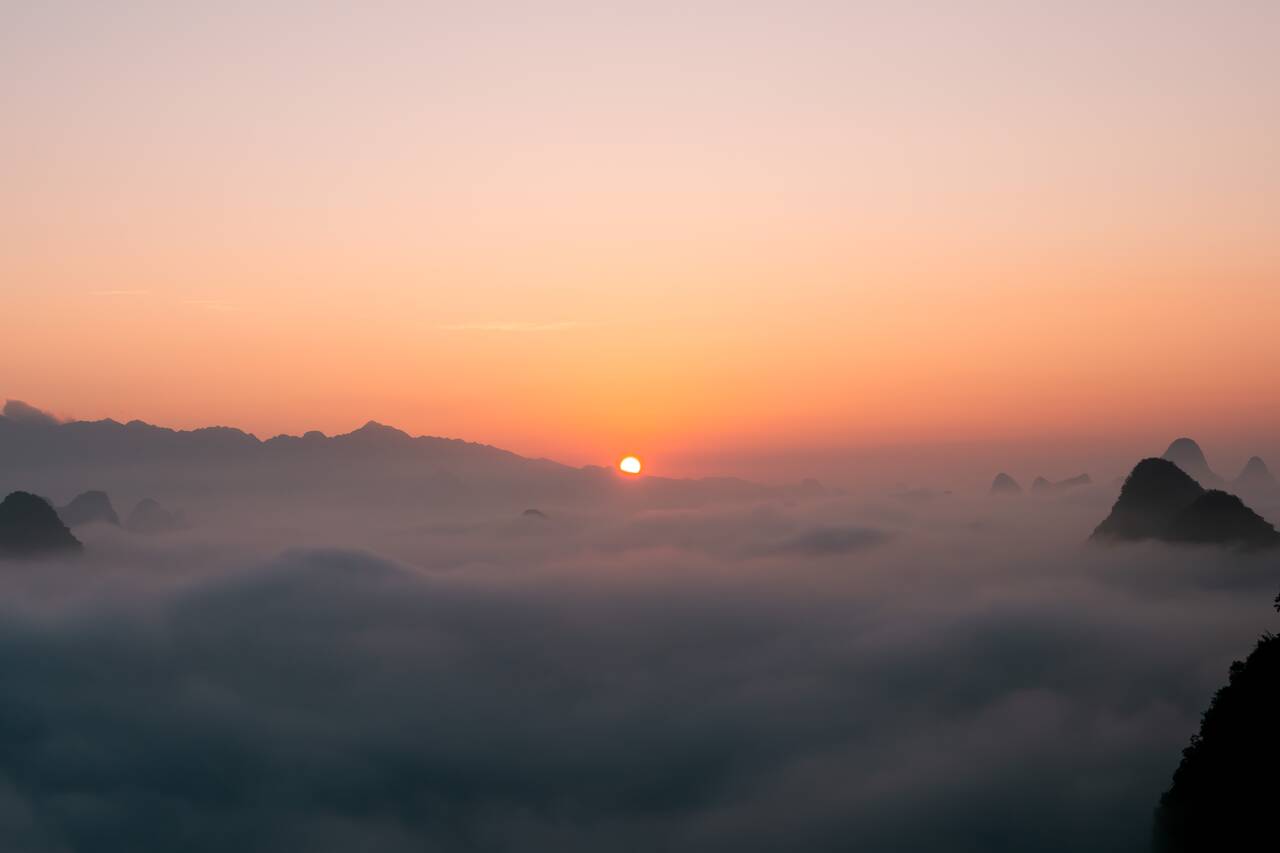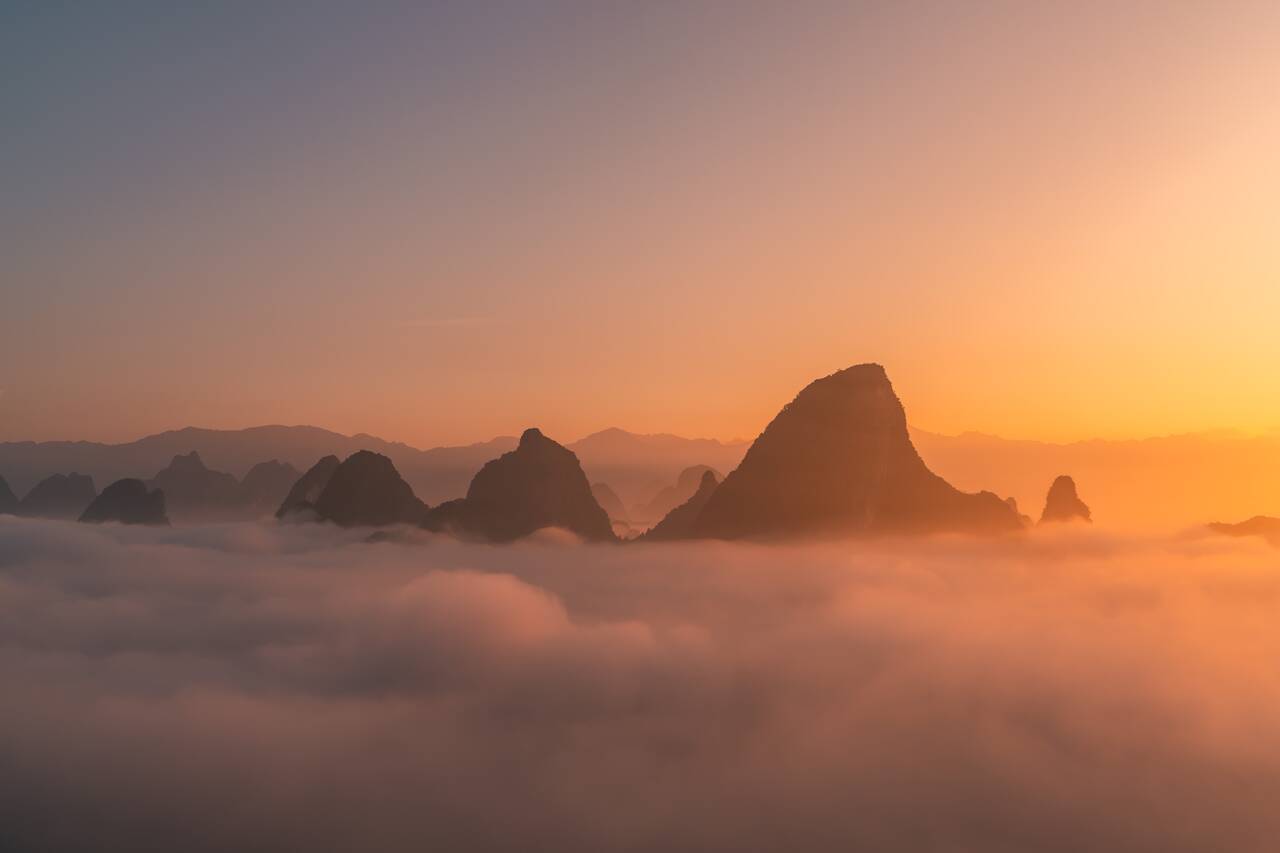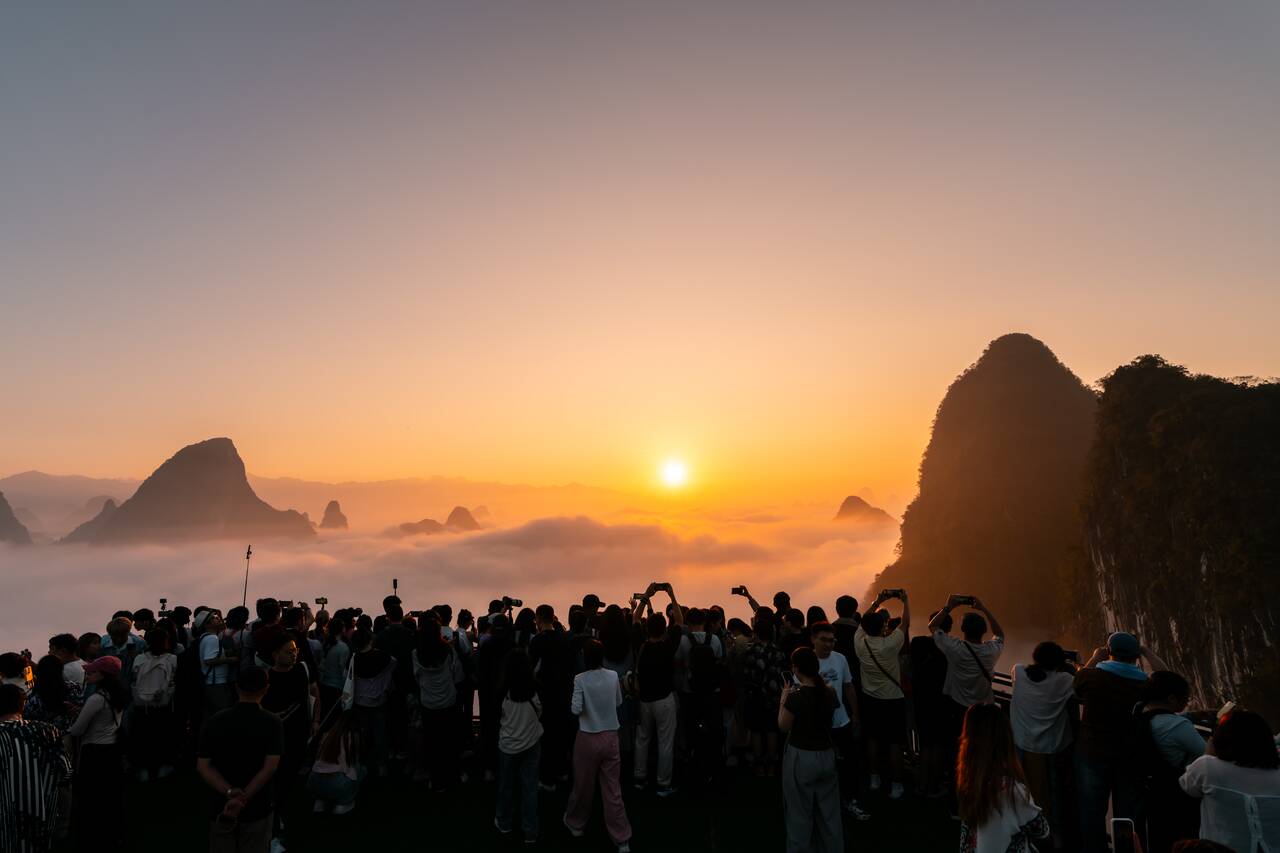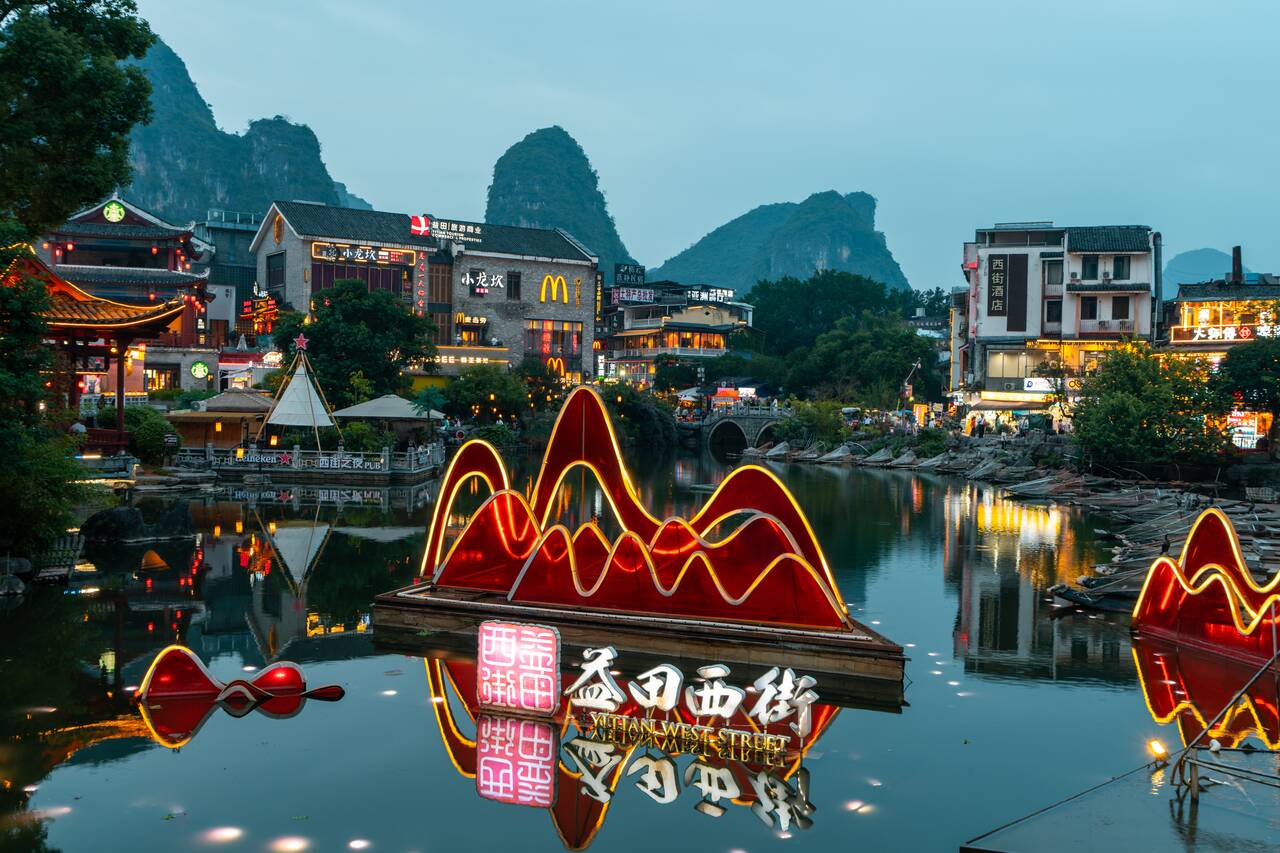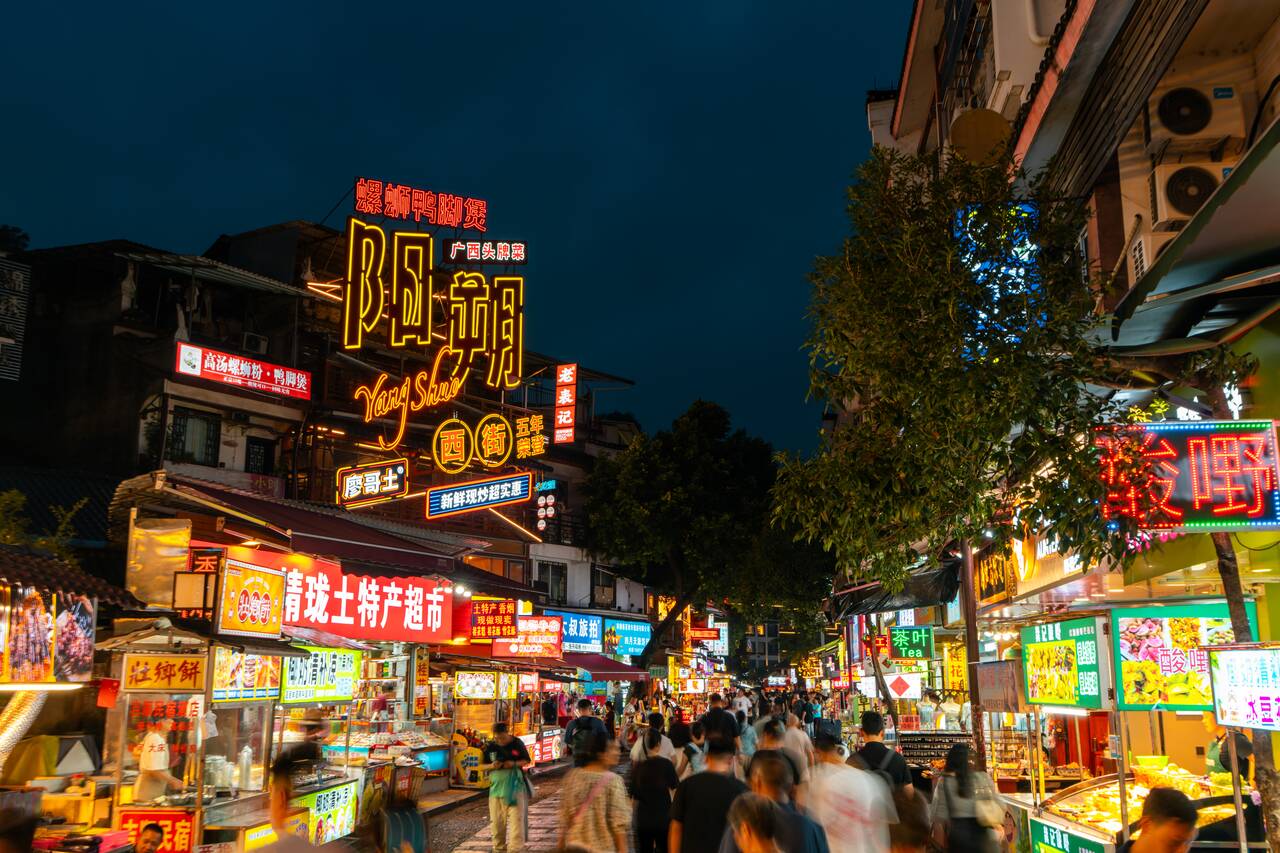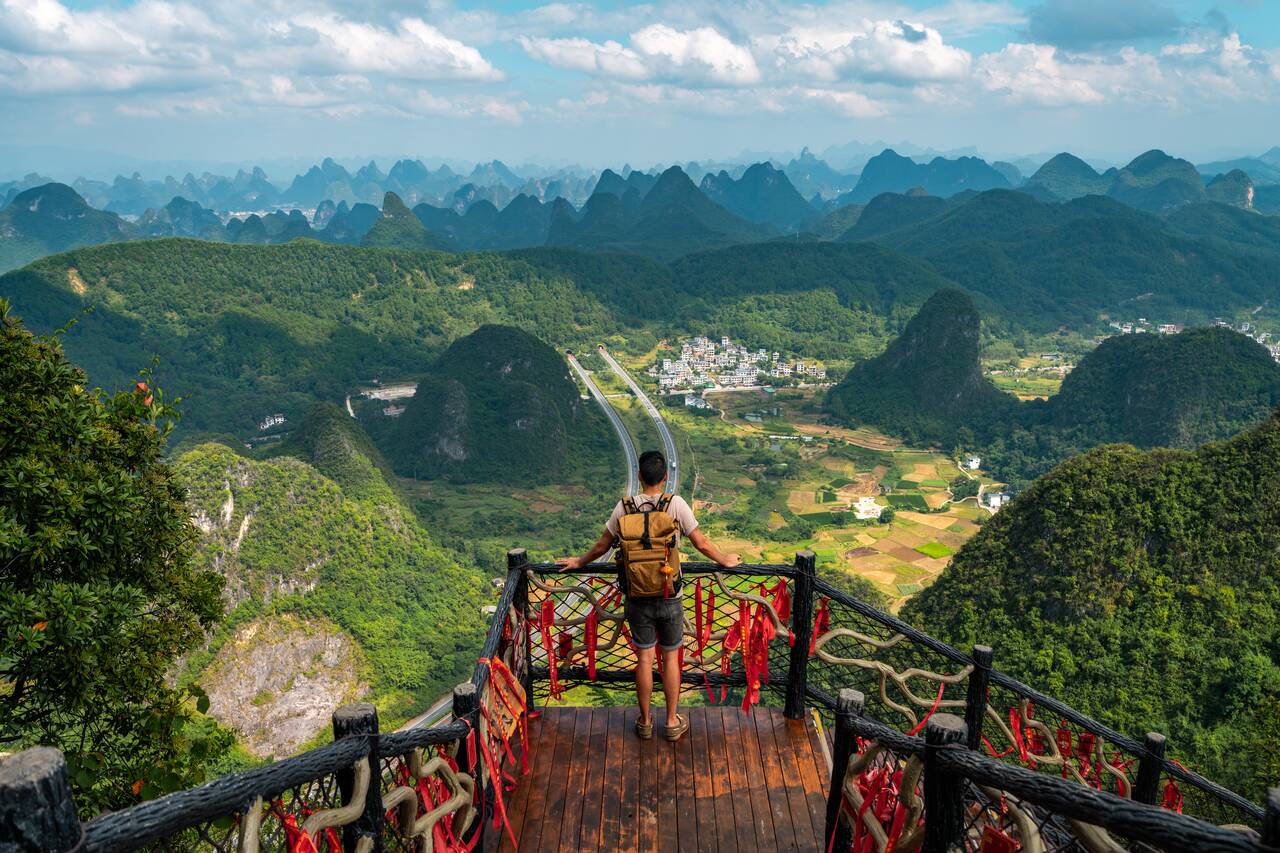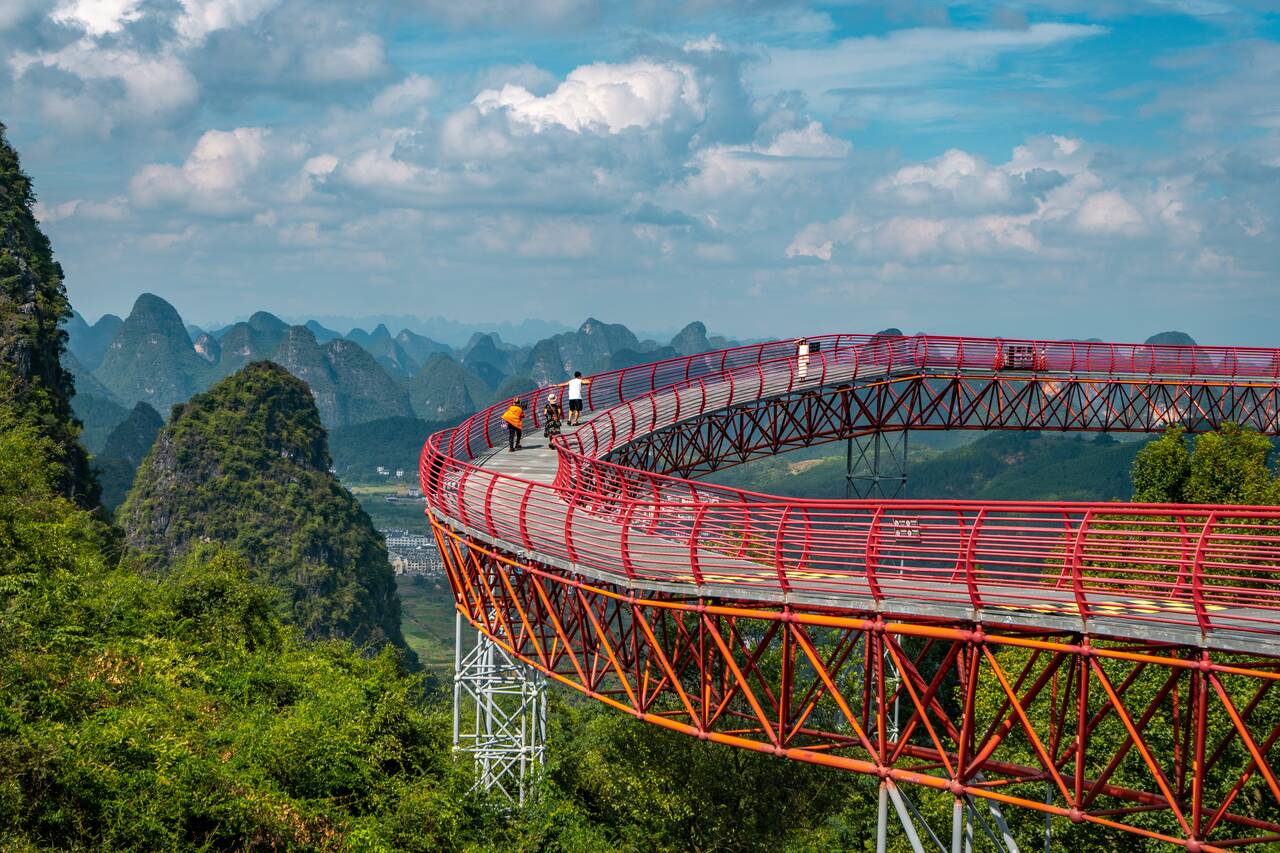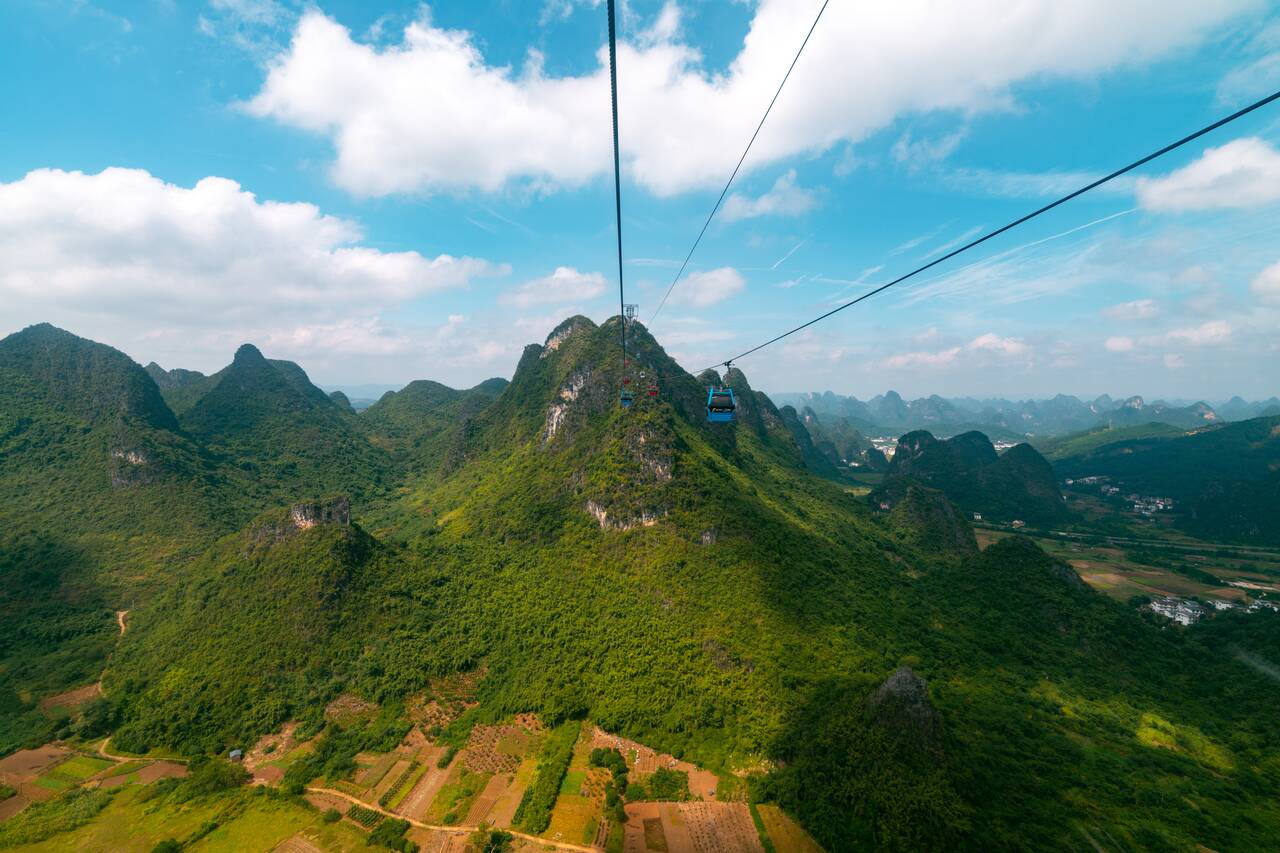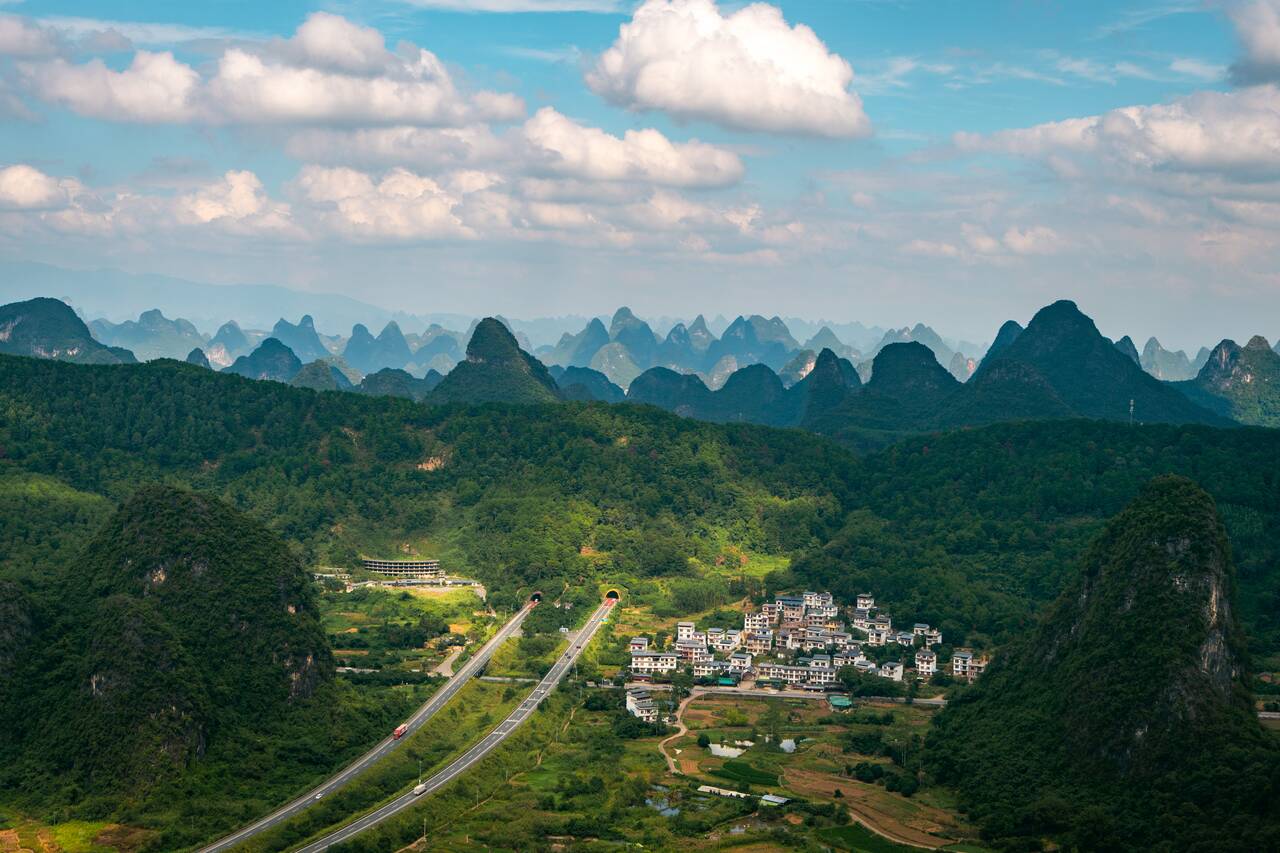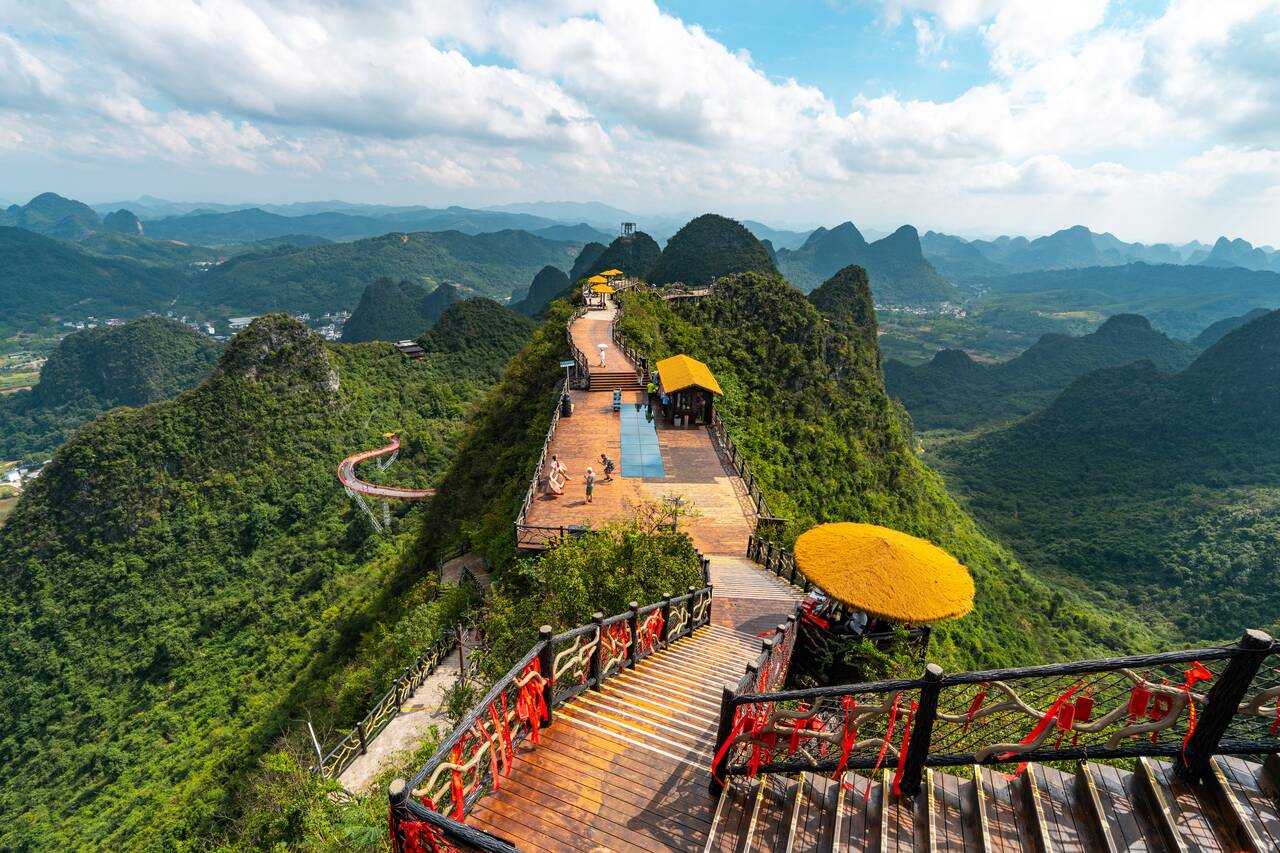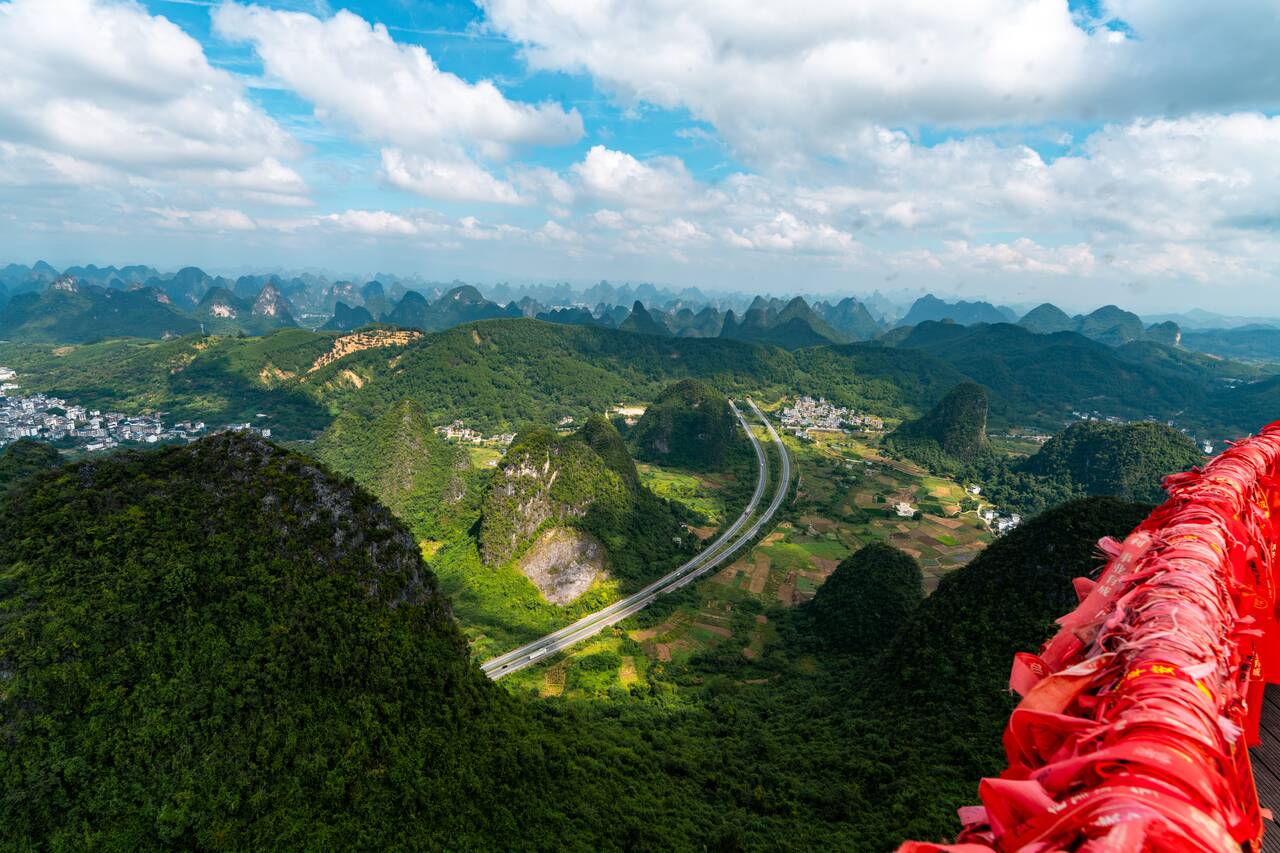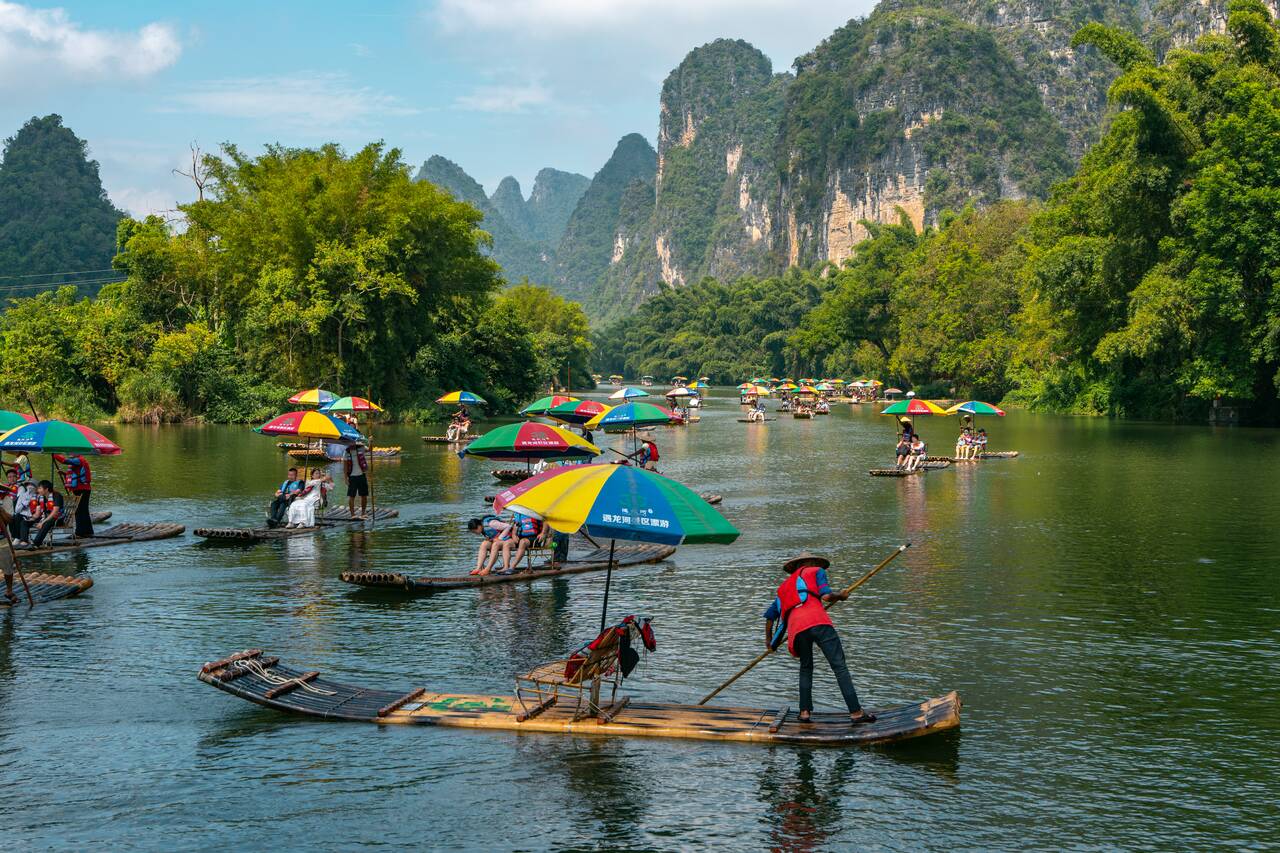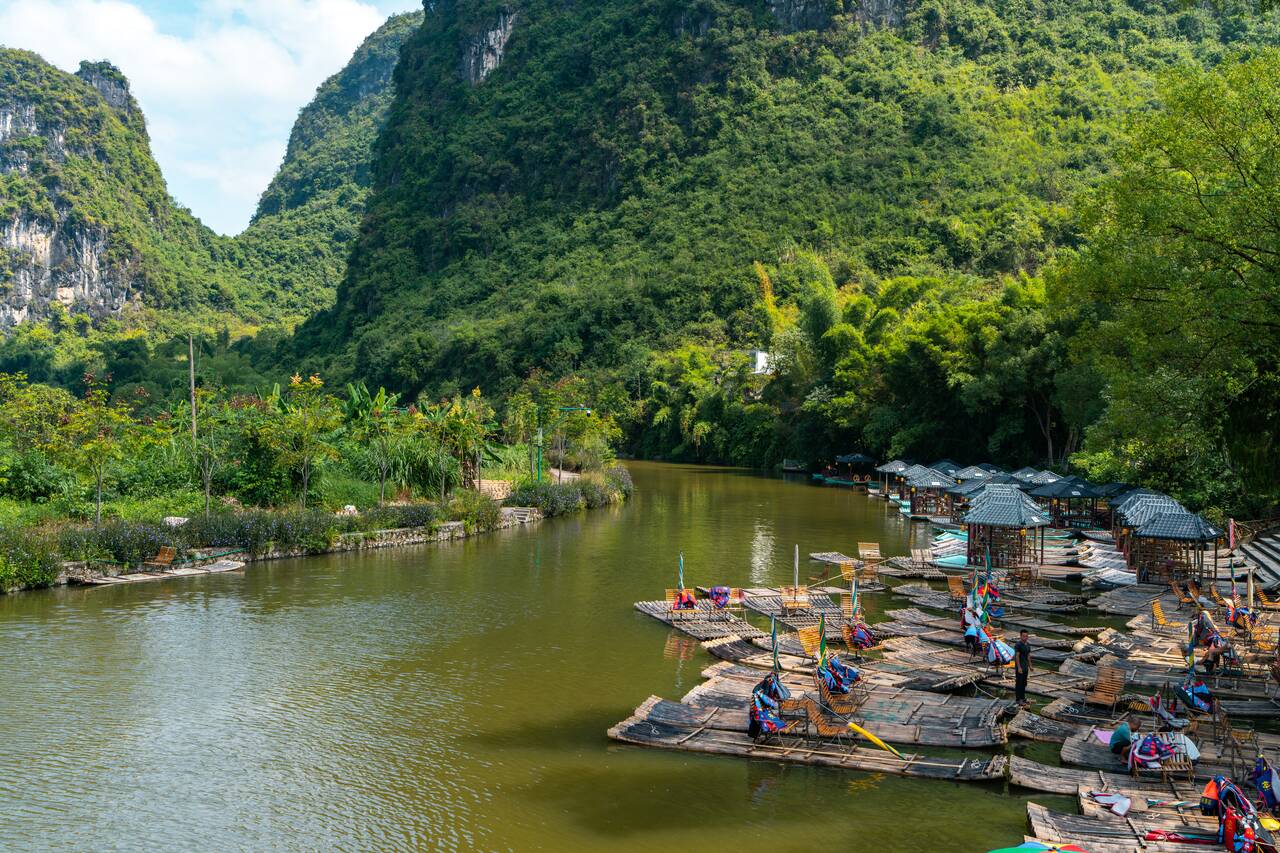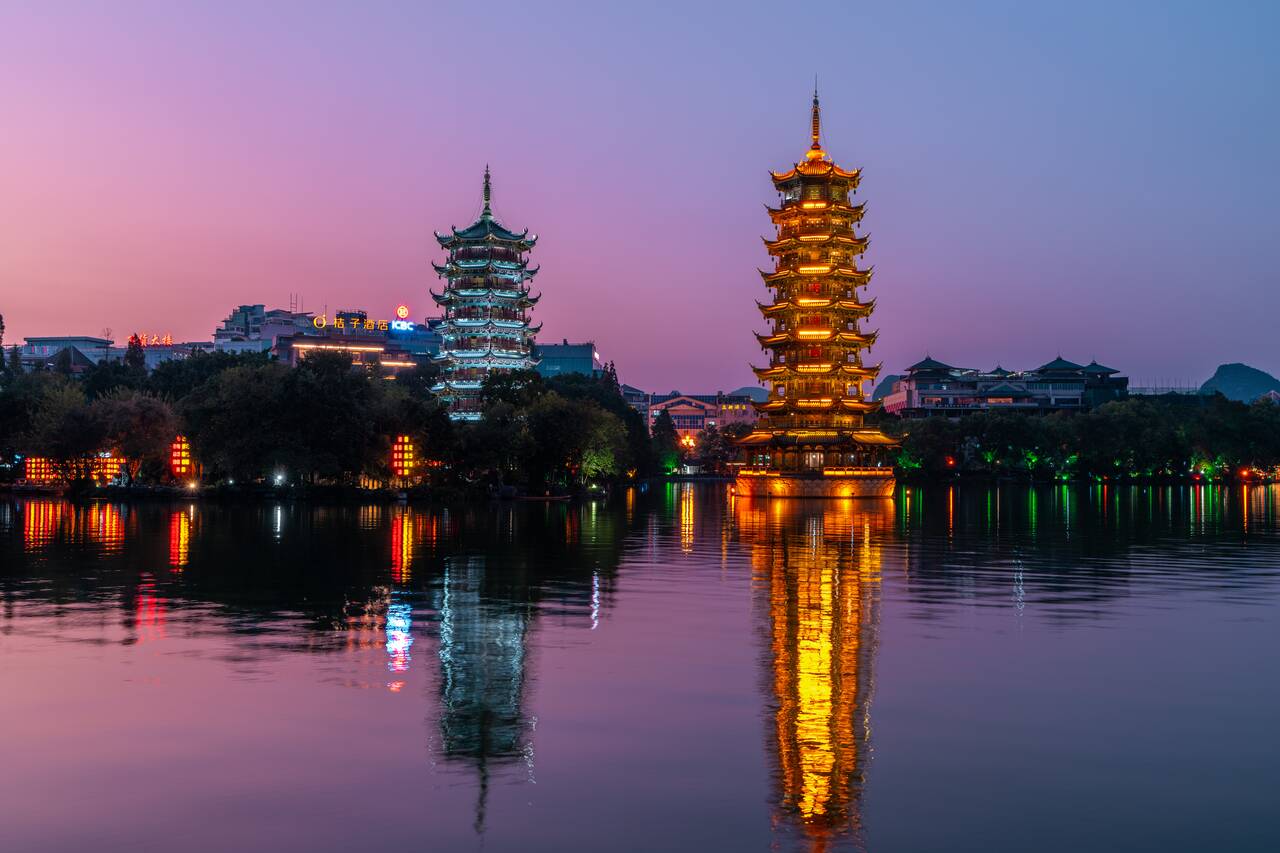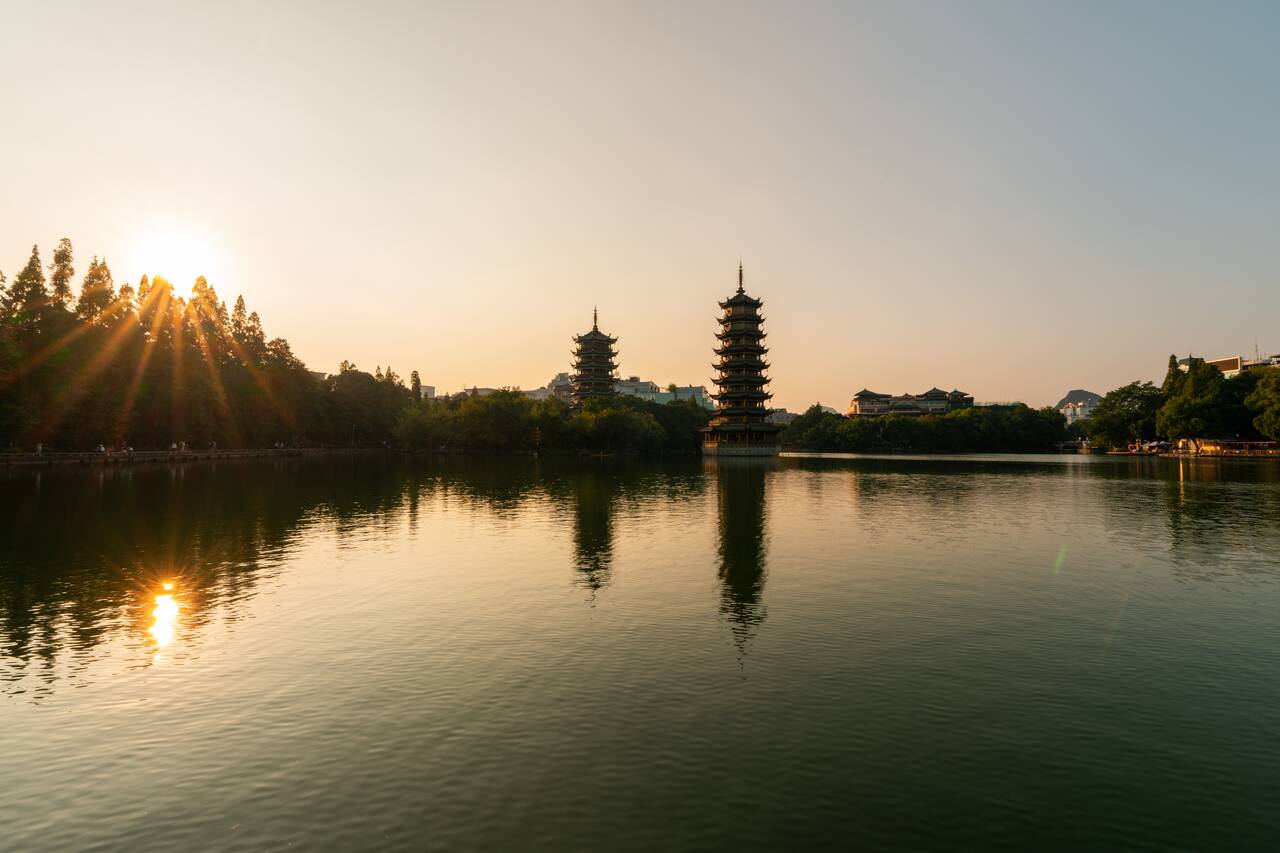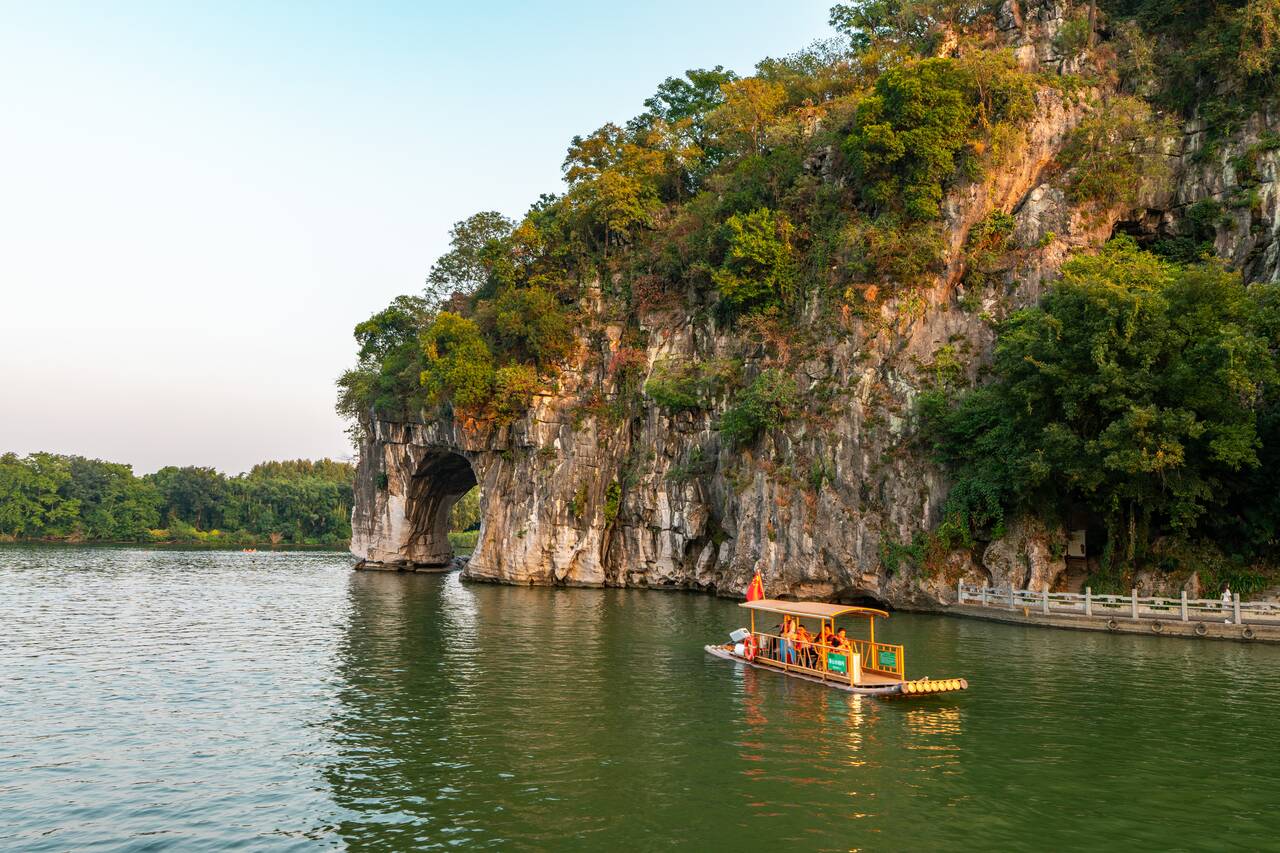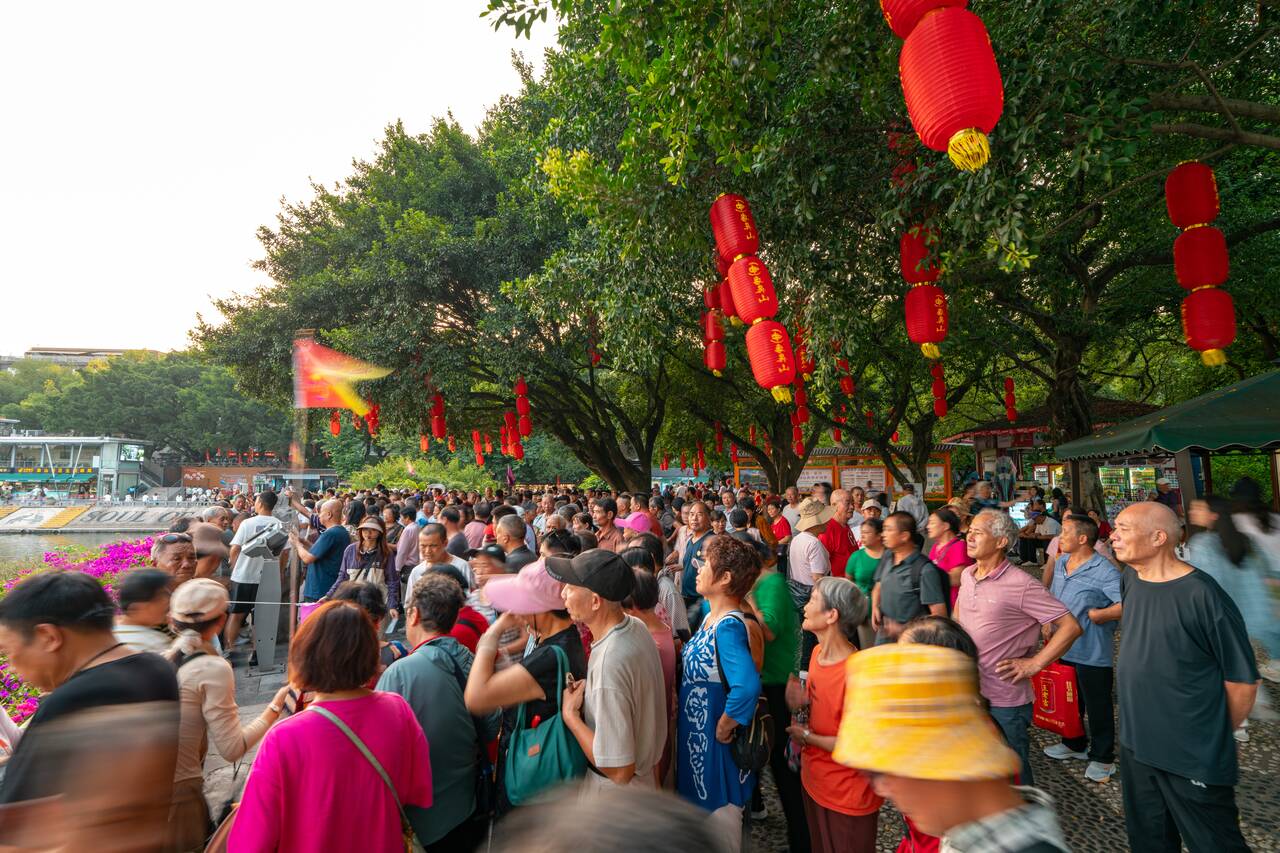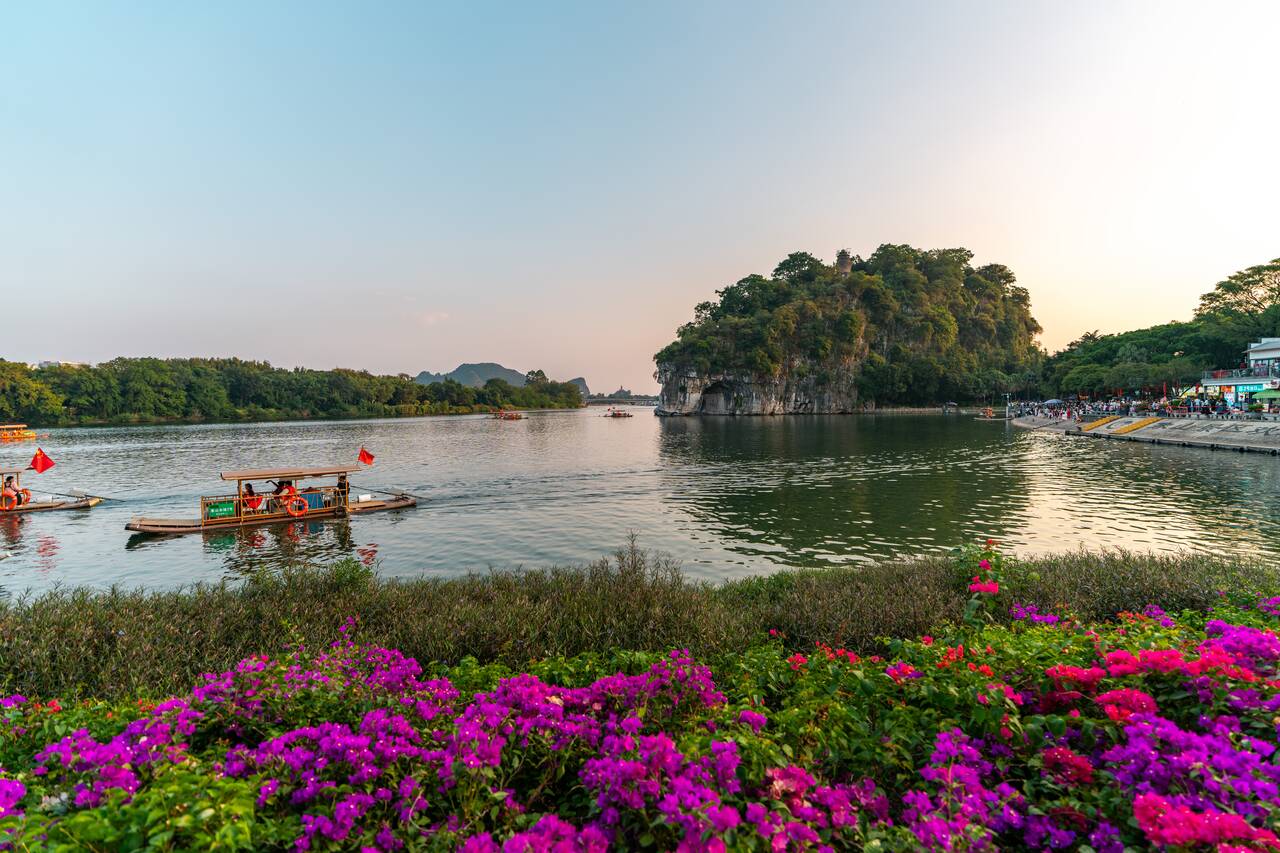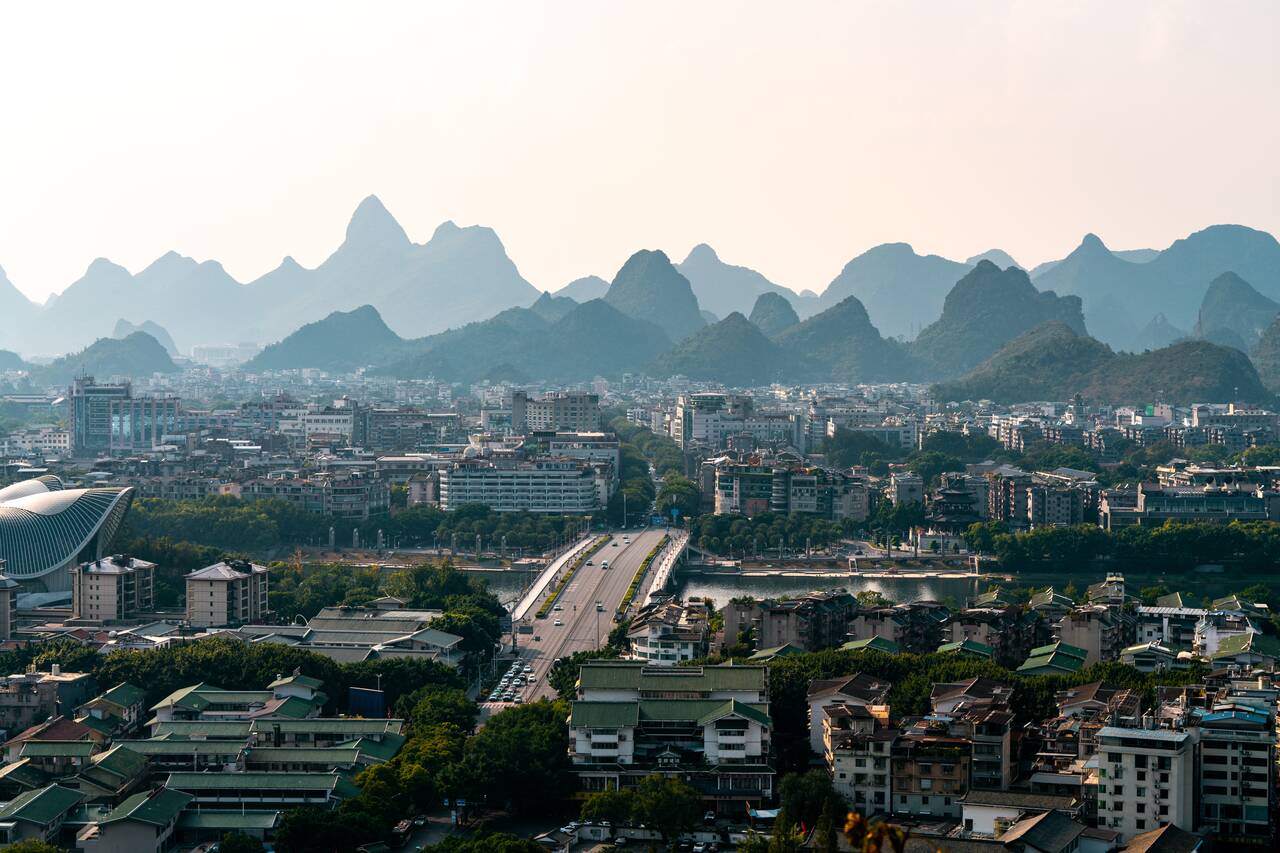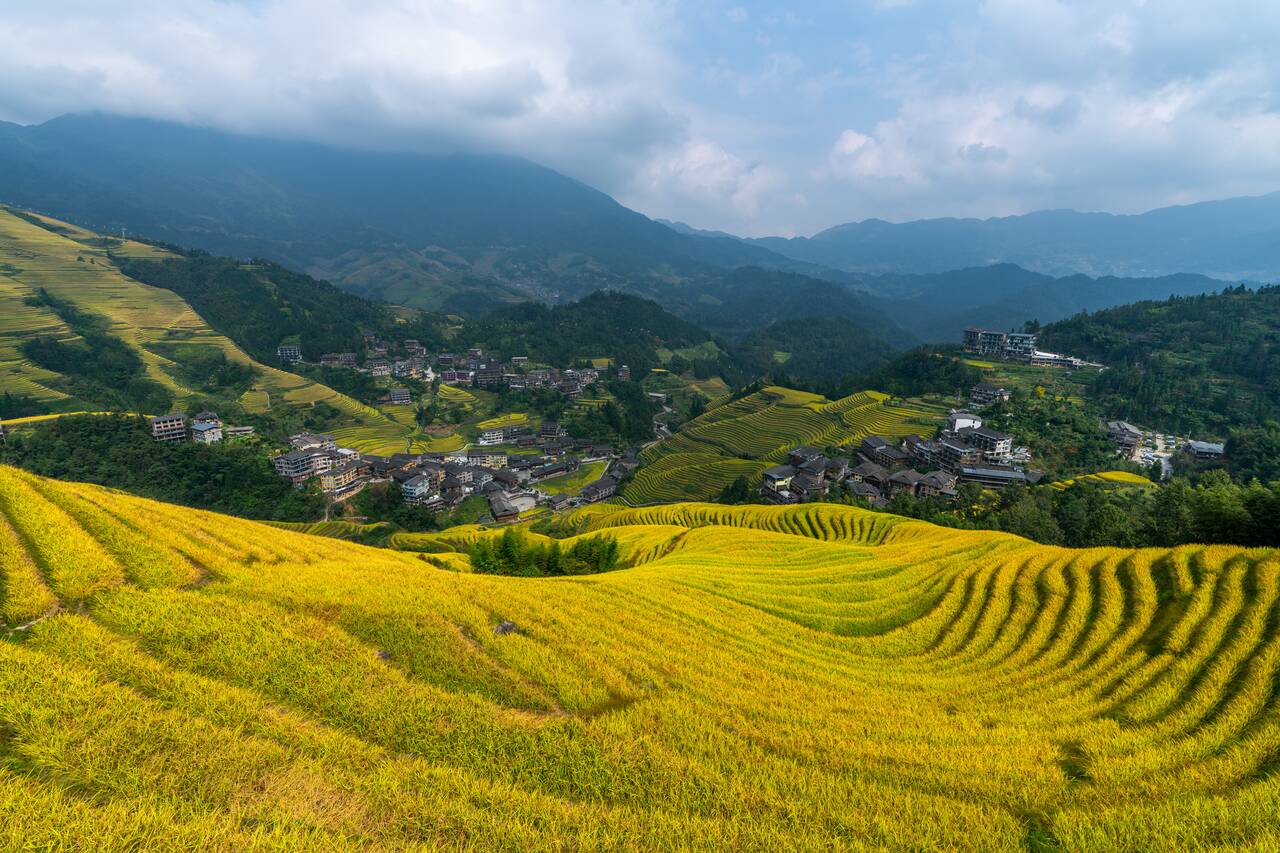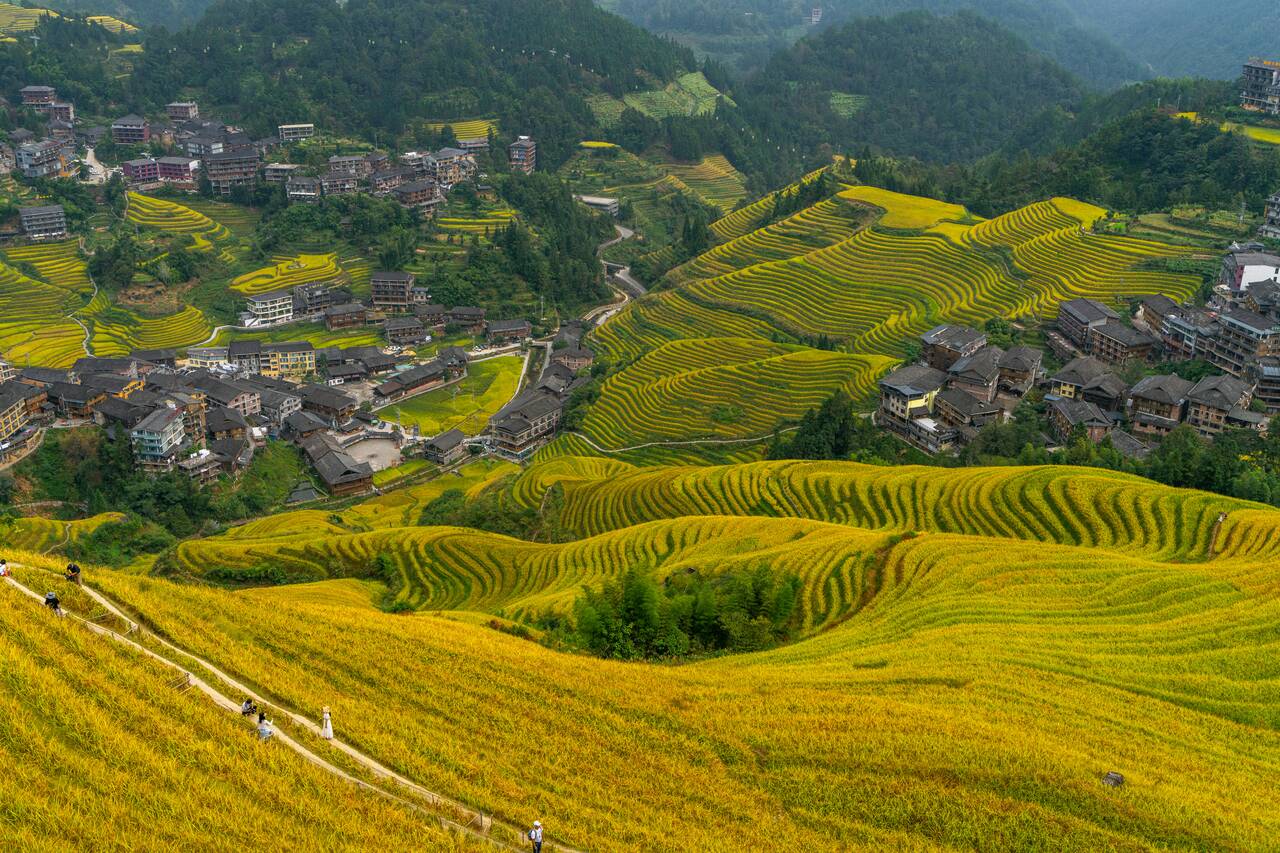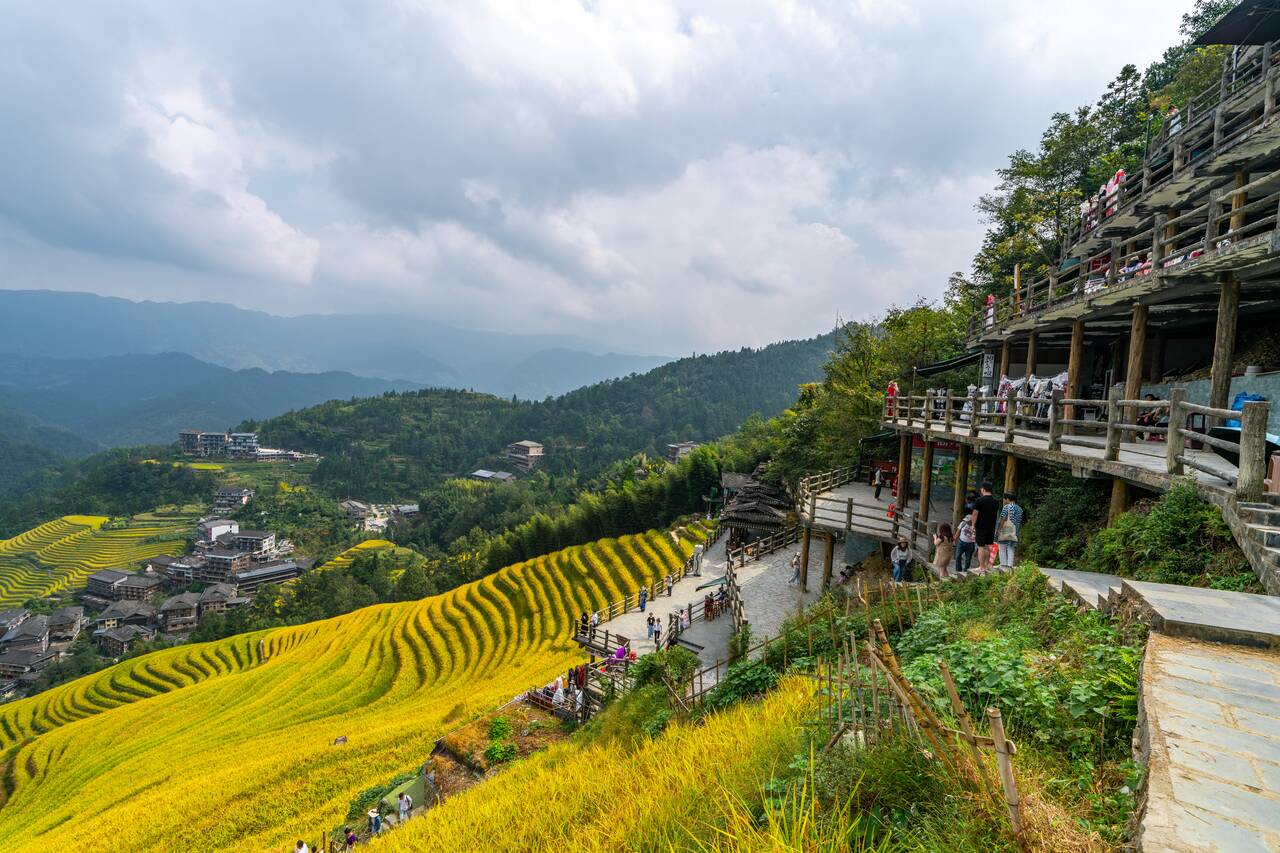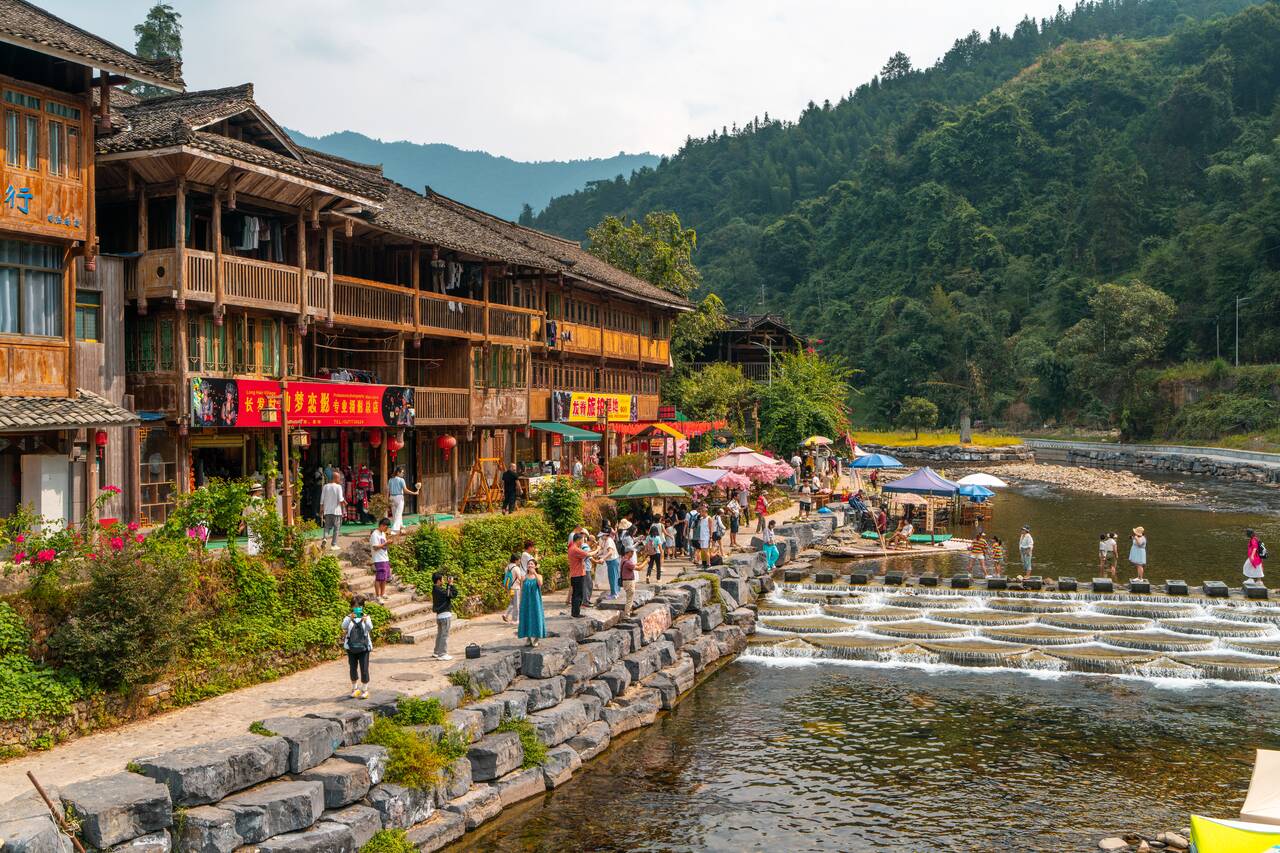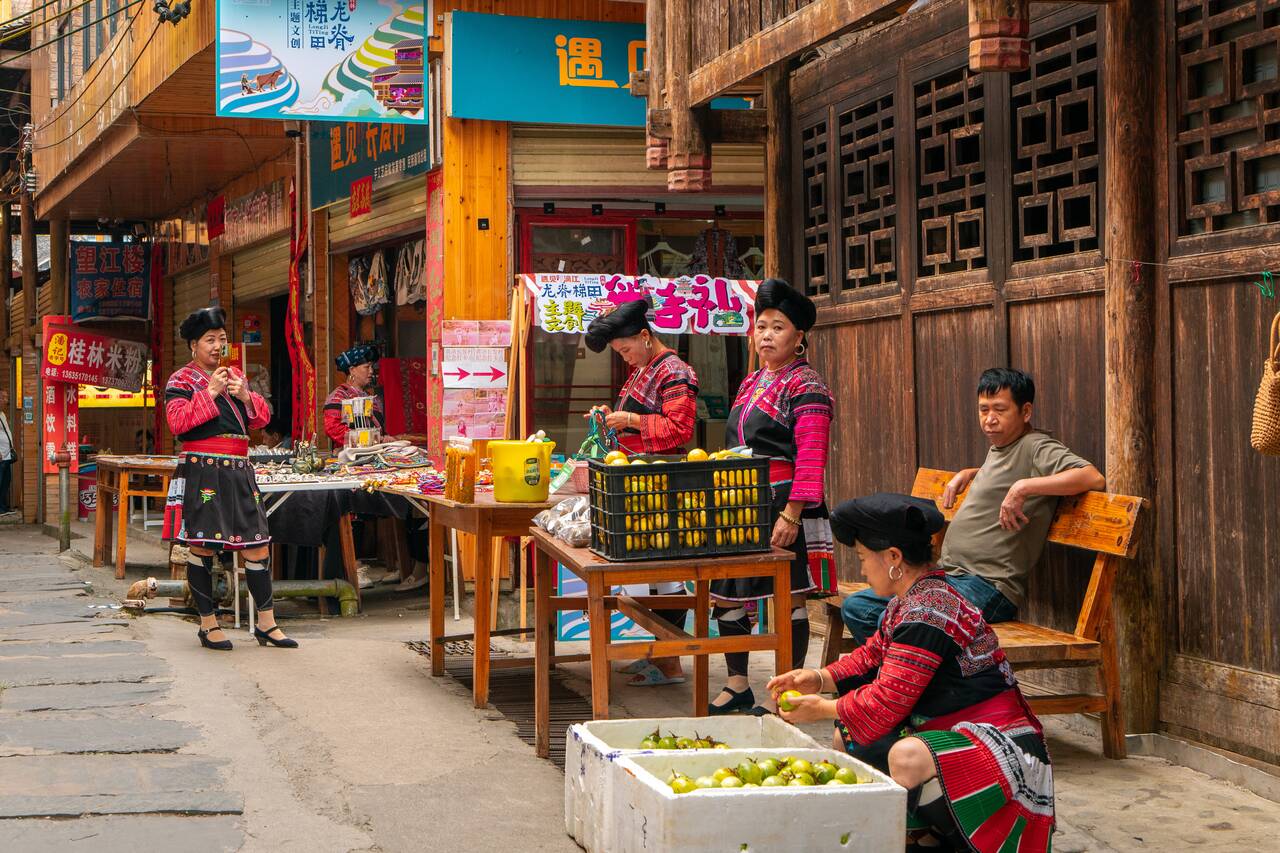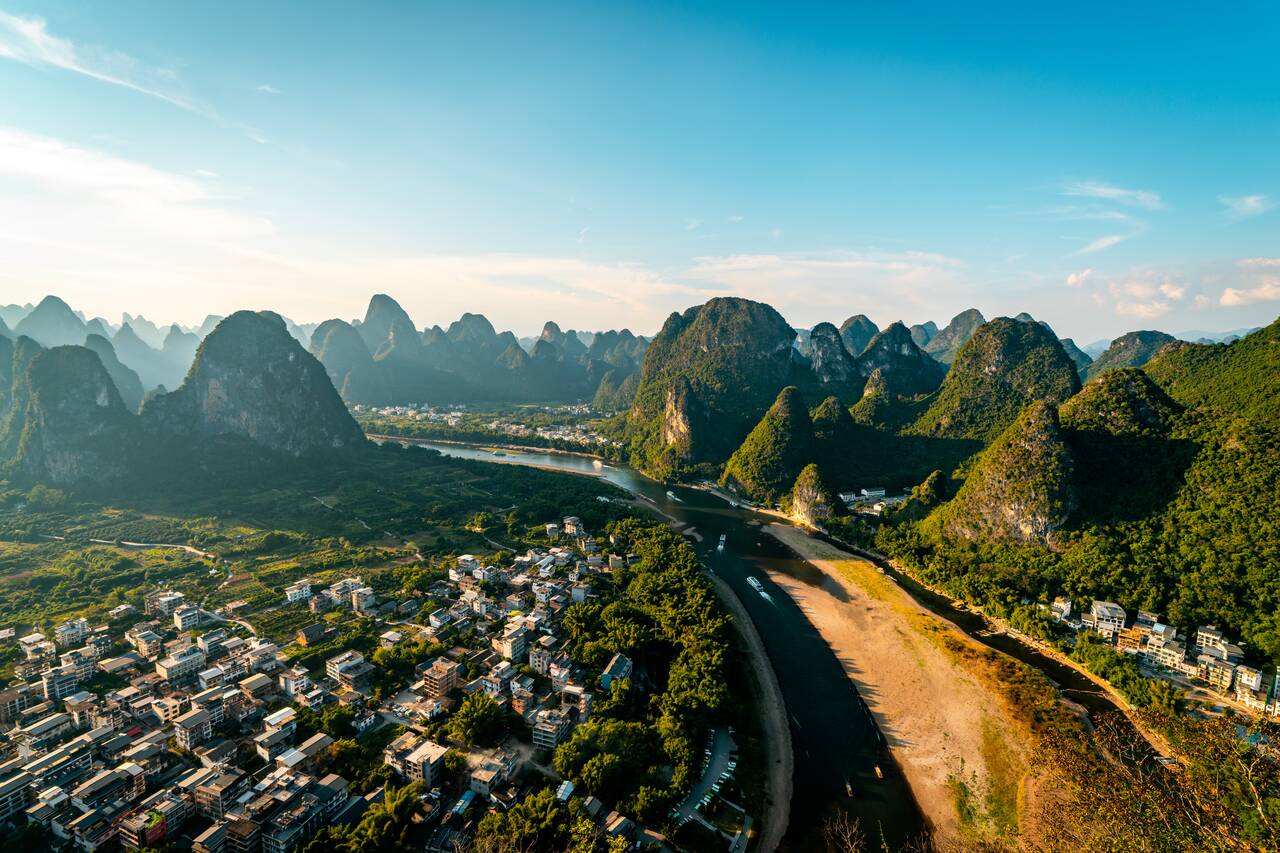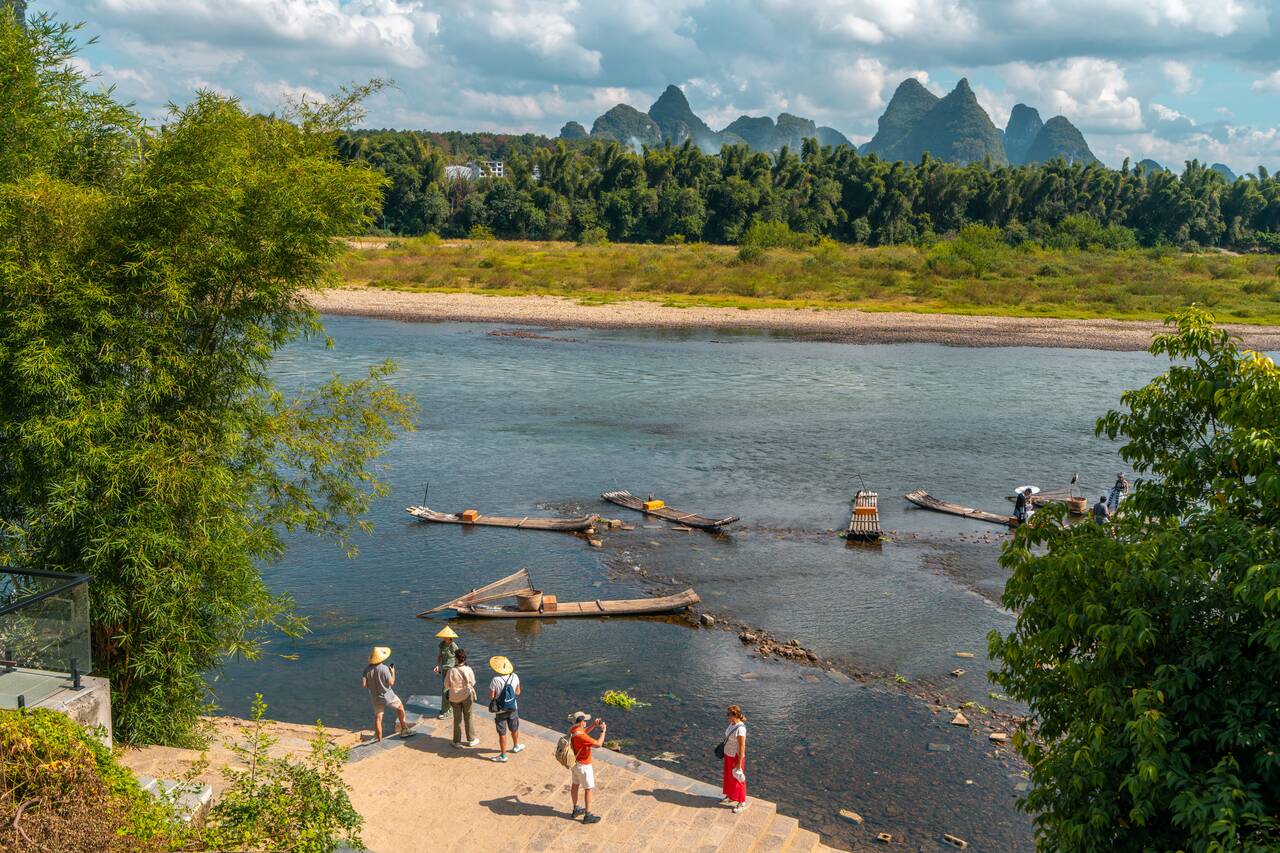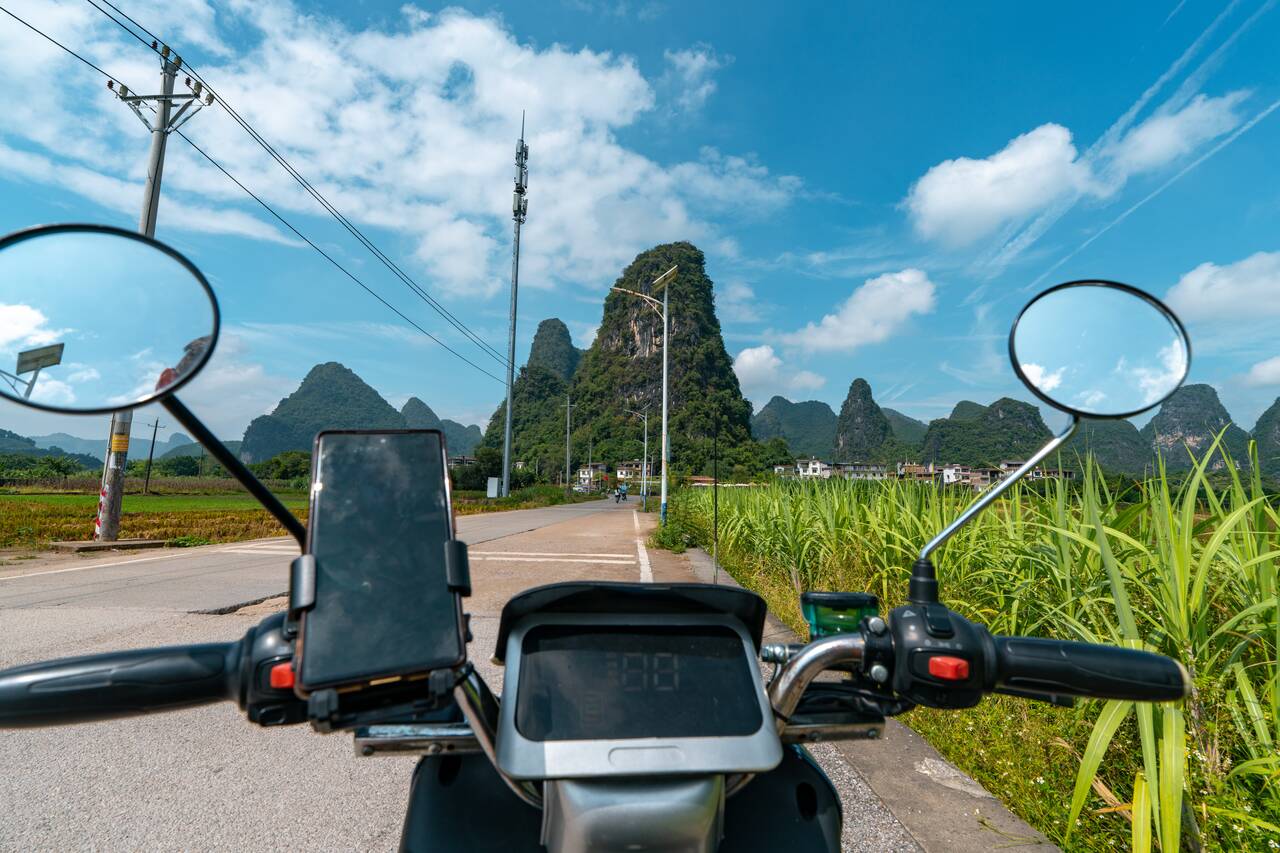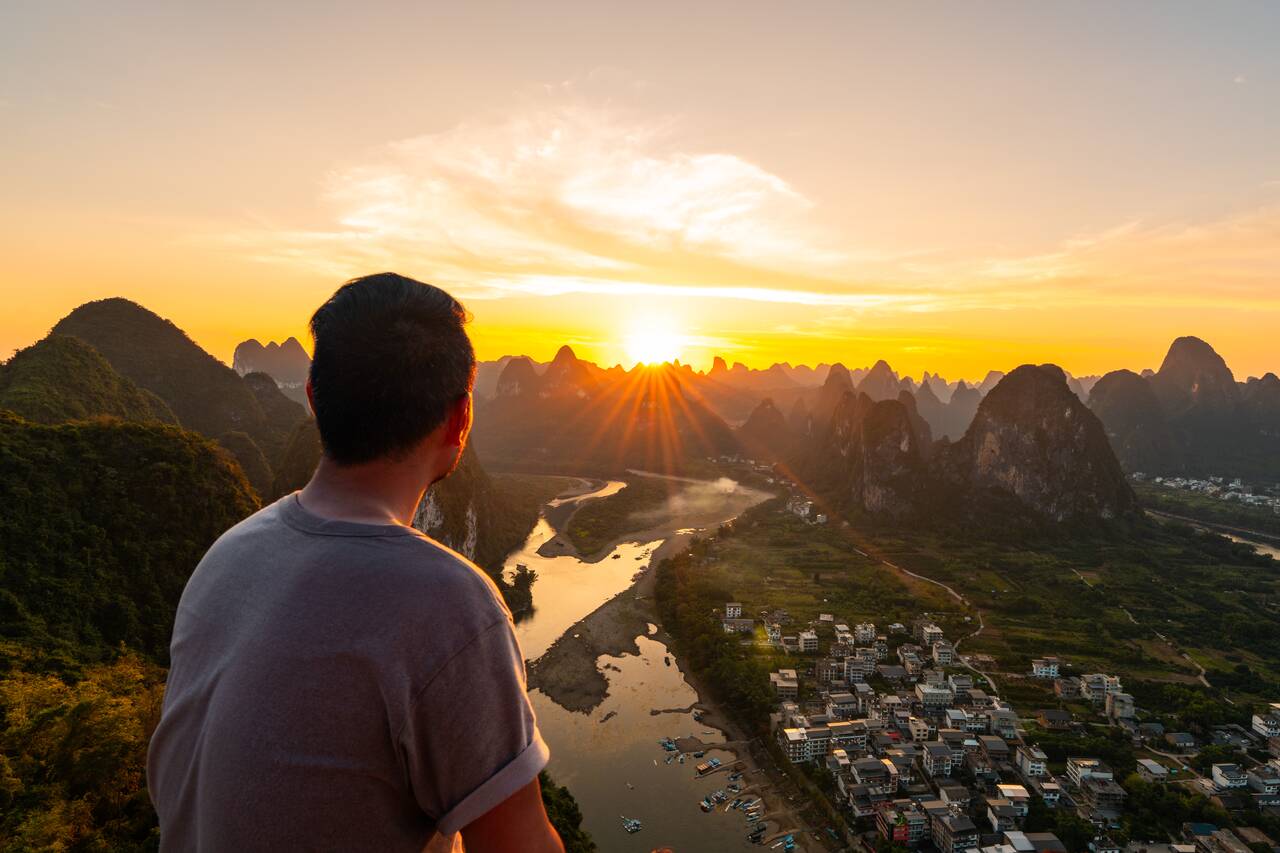I spent over a month traveling around Southern China, and of all the places I visited, Guilin is, hands down, one of my favorites. With its iconic karst mountains, peaceful rivers, charming ancient villages, and endless viewpoints, the entire region feels like it was pulled straight out of a painting.
Fun fact: the peaks of Guilin actually inspired the landscape in the famous Japanese manga/anime "Dragon Ball", where young Goku used to live 😉. Whether you’re here to see that, cruise along the Li River, or hike up to one of the many viewpoints to catch the sunrise or sunset, Guilin will leave you speechless at every turn.
In this complete travel guide, I’ll walk you through everything you need to know about Guilin, from the best things to do and where to stay to how to get around, when to visit, and all the little tips I picked up along the way. So without further ado, here’s your complete travel guide to Guilin. Let’s start planning, shall we?
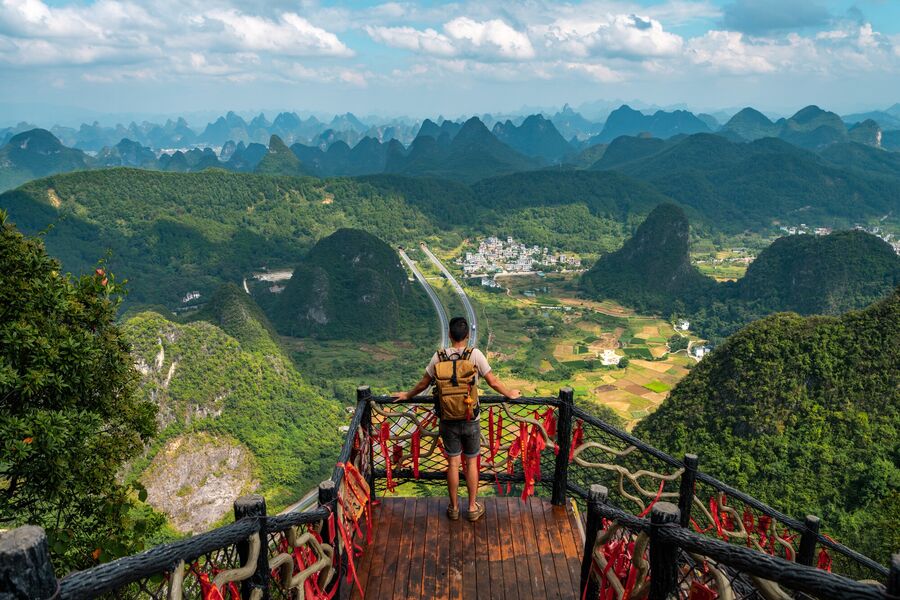
- Guilin Things to Do Map
- Where to Stay in Guilin?
-
11 Best Things to Do in Guilin
- Hike Up Lao Zhai Shan Hill for Sunset
- Explore Xingping Ancient Village
- Cruise the Li River
- Watch the Sunrise at Xianggong Viewpoint
- Visit Yangshuo West Street
- Explore Ruyi Peak
- Go Bamboo Rafting on the Yulong River
- Stroll Around the Sun and Moon Pagodas
- Check Out Elephant Trunk Hill
- Hike up to the viewpoint at Seven Star Park
- Go on a Day Trip and visit Longji Rice Terrace
- Things to Know Before Visiting China
- When to Visit Guilin?
- How to Get to Guilin?
- How to Get Around Guilin?
- How Many Days to Spend in Guilin?
- What to Pack for Guilin?
- Further Reading for China, Hong Kong, and Macau
Guilin Things to Do Map
Where to Stay in Guilin?
Guilin sits within the South China Karst, a vast UNESCO World Heritage area that spans multiple provinces, but the most beautiful part is the Guilin–Yangshuo karst belt which covers roughly 2,000–3,000 km² and runs along the Li and Yulong River. Within its proximity, you will find many towns and cities scattered across the area, which begs the question, which city to stay at.
After spending almost a week here, here’s my recommendation on where to stay in Guilin. First and foremost, you’ll need to get into Guilin City via high-speed train and stay at least one night. If you plan to visit the Longji Rice Terrace, consider staying two nights so you can take a day trip the next day. My recommended accommodations in Guilin City are listed below:
After Guilin City, you can take a cruise to Yangshuo, which is where all the beautiful karst mountains are. You can spend 2-3 nights here and explore the rivers, as well as all its beautiful viewpoints like Ruyi Peak and Xianggong Viewpoint. Below are the recommended accommodations in Yangshuo:
Last but not least, I highly recommend you stay 1 night at Xingping as well, which is another ancient city located right next to Yangshuo High-Speed Railway Station, a perfect stop before you leave Guilin. The ancient town in Xingping is really nice and you can hike up to Lao Zhai Shan Hill for sunset, which is hands down one of my favorite viewpoints in Guilin. Below are my recommended accommodations:
11 Best Things to Do in Guilin
1. Hike Up Lao Zhai Shan Hill for Sunset
Probably one of the most beautiful viewpoints in Guilin, Lao Zhai Shan Hill is a steep karst mountain located right next to Xingping Ancient Village. You can hike up to see the stunning Li River winding around the jagged peaks of Guilin's karst landscape.
Because of its proximity to the town, it is one of the most popular sunset spots and attracts large crowds, including both local and foreign tourists. The view from the top is absolutely breathtaking, truly unlike anything I’ve seen before, and it is definitely worth the hike despite the crowds.
The hike is quite steep and can be challenging at times, mostly due to how hot and humid the weather is, even in mid-October. But once you reach the top, you will completely forget how tired you were and be blown away by its sheer scale and beauty.
- Longji Rice Terraces Day Trip
- Yangshuo Xiangong Mountain Day Trip [Sunrise/Scenic View Tour Available] 🏅 Top Pick
- Li River Cruise
The hike starts from this spot shown in the photo above, and you should be able to walk there from Xingping Ancient Village. From the trailhead, the hike should take about 30 minutes without rest up an extremely steep trail.
I started around 4 PM and reached the top by 4:30 PM, finding only a few people at the viewpoint. The area becomes much more crowded as sunset approaches, making it harder to find a good spot to sit and enjoy the view. I highly recommend arriving an hour or two before sunset and staying until nightfall to fully experience the sunset.
At the top, you will find a pavilion where you can rest from the hike and enjoy the view of Xingping from above. If you scramble a little further up a jagged karst peak, you will be able to see the view from the other side, where the river bends and snakes around the hundreds of karst peaks that Guilin is famous for. Just be careful when climbing higher, as the path is narrow and the rocks are sharp.
I sat there for two hours, enjoying the golden and blue hours with another fellow solo traveler. Shout out to you, Lisa. It was magical. The sun’s rays lit up hundreds, if not thousands, of the vertical karst peaks, creating depth and shadows that shifted as the sun dipped behind the horizon. Set against the changing colors of the sky, from blue to orange to purple, life just doesn’t get better than this!
This hike is the reason I recommend staying an extra night in Xingping. It was truly the highlight of my trip, and I highly suggest making it up here at sunset. Be sure to bring enough water and wear sturdy shoes for the hike. Trust me, you are going to love it!
2. Explore Xingping Ancient Village
Before hiking Lao Zhai Shan Hill, you can also visit Xingping Ancient Village, a charming riverside town that feels like stepping back in time. It is famous for its well-preserved old streets, traditional architecture, and stunning views of the Li River winding through karst peaks, unlike Yangshuo, which has been heavily commercialized 😅.
The village is smaller and quieter than Yangshuo, with its wooden traditional houses lining the cobblestone streets. There is some commercialization happening here as well, but not to the same extent as Yangshuo. If you walk a little bit away from the main touristy area, you can still see people living in these houses, which I think is pretty cool.
Along the cobblestone streets, you will find many lovely cafes and bakeries where you can sit back, relax, and soak in the atmosphere. The town does get crowded during the day with day trippers from Yangshuo, but if you stay overnight, the mornings and late evenings are my favorite times to explore, when you can truly enjoy the peaceful quiet of the village.
Other than shops and cafes, you can also check out some of its old and preserved architecture like Wu Cheng Temple, a historic Qing dynasty site where you can stroll around and explore its beautiful courtyard and interior, as well as other beautiful and photogenic streets, so be sure to spend some time and explore thoroughly.
Here, you will also find one of the most popular photo spots, the 20 CNY viewpoint, where you can get that iconic photo of the karst mountains with the river as featured on the 20 CNY banknote. There is a dedicated spot to take that photo, but you have to pay for it. Don't, as you can get the exact same view next to it or from the balcony located on the second floor of the pier for free.
3. Cruise the Li River
One of the highlights of visiting Guilin is to cruise along the Li River and admire the true beauty of Guilin and its karst mountains along the way. This is how I traveled from Guilin City to Yangshuo, and it is hands down the best and most photogenic way to do it.
The cruise often takes about 6 hours and you can book it in advance here or through your accommodation. The tour should pick you up at 7 or 8 AM at your hotel in Guilin City, and you will be transferred to the pier, which will take about an hour.
Once you arrive at the pier, your guide will purchase the ticket for you, and you can board the boat according to the boat and seat number provided. The boat usually departs around 10 AM, and you should arrive at Longtoshun Wharf by 2 PM, making the journey approximately four hours, six hours in total including bus transfers and boarding.
There are several cruise types: 3 stars, 4 stars, and 5 stars, with varying quality and price. I found the difference between each level not enough to encourage me to pay a premium, so I went with 3 stars costing me about 64 USD, and it was actually very good. With the 3-star cruise, you will get a very comfortable seating area accompanied by dry snacks and tea that you share with other passengers.
You do not get lunch with the 3 stars but you have dried snacks to help sustain you until you arrive in Yangshuo for late lunch. I thought the whole cruise was great and not crowded at all, as some travel guides suggested. I highly recommend you go with a 3-star cruise if you want to travel from Guilin to Yangshuo.
The views along the way are absolutely incredible. I thought I might get bored after a few hours, but I was completely wrong. I spent more than 70% of the four-hour Li River cruise on the deck, enjoying the scenery and taking photos of the countless karst mountains along the way. There are hundreds, if not thousands, of them, which is what surprises me most about Guilin.
The cruise offers a perspective of Guilin that you can’t get any other way, bringing you close to places that are difficult to reach by land. You’ll also see people traveling along the river on bamboo rafts and discover riverside towns you would have otherwise missed. It is definitely worth it, so when you are in Guilin, do not miss this experience!
4. Watch the Sunrise at Xianggong Viewpoint
Xianggong Viewpoint is one of the most iconic viewpoints along the Li River. From the top, you can see the river bend in a dramatic horseshoe shape, surrounded by countless karst peaks stretching into the distance, and it is one of my favorite viewpoints in Guilin.
With its vantage point and unique scenery, Xianggong Viewpoint is probably the most famous place to watch the sunrise in Guilin, with the morning light casting beautiful shadows and creating depth and layers across the mountains. You can find many organized tours that will take you to Xianggong Viewpoint as early as 4 AM so you can catch the sunrise in time.
I went with this organized tour and they picked me up at my hotel around 4 AM. We arrived at the viewpoint by 5 AM, just in time for the entrance gate to open. The tour also bought me the ticket prior, so we didn't have to queue up and could enter the gate right away. From the gate, it is a short 10-minute hike to the platforms where you can watch the sunrise.
There are about three levels of platforms you can choose from, and you’ll need to act quickly to secure your spot. It gets crowded very fast, and the best front-row spots with an unobstructed view can be taken within minutes. If you find one, stay there and stand your ground. Trust me, if there is even a slight space next to you, someone will squeeze themselves in.
Once you secure your spot, don’t move until sunrise. Trust me, you won’t find another open space on the platforms, as local tourists will quickly fill the area. You just need to beat them to it during the hike to get a good viewing spot.
I ended up waiting about two hours before sunrise, and even though my legs were getting tired, it was worth it. The scenery, with rolling clouds below and countless karst peaks piercing through them, set against the purple and orange hues of the morning sky, felt almost like a Chinese painting. It’s no wonder that traditional Chinese paintings depict landscapes this way when places like this exist in reality!
Although it was crowded the entire time, I think it was worth the trouble. I mean, look at the photos I took here. It was magical, and I've never seen anything quite like it. With this kind of view, it's not hard to see why Guilin is so popular. The place definitely deserves all the hype it was given. Absolutely breathtaking.
You should return to your shuttle around 7:30 AM, and it will take you back to your hotel in Yangshuo by 8:30 AM. This gives you time to rest before checking out of your hotel, or you can spend the rest of the day exploring Yangshuo. Watching the sunrise at Xianggong Viewpoint is one of the best experiences I’ve had here, so if the weather permits, be sure to get up early. Trust me, you won’t regret it.
5. Visit Yangshuo West Street
Although Yangshuo is highly commercialized and no longer the authentic ancient village it once was, it still has its charm. If you are spending a few nights in town and are looking for lively things to do, Yangshuo West Street is where all the action happens, with the street lined with shops and restaurants to explore and enjoy.
Most places in Guilin are fairly quiet at night, but Yangshuo has the liveliest streets, especially after sundown, with restaurants and street food stalls bustling with people. It’s perfect for those looking for a vibrant night scene, but not so much for those seeking peace and quiet.
If you prefer a peaceful night, staying in Xingping Ancient Village is a better option. But if fun is what you’re after, Yangshuo is the place to be. It also serves as a good base for exploring other parts of Guilin, such as Xianggong Viewpoint, where tours often depart, bamboo rafting along the Yu River, and Ruyi Peak, both of which we will discuss next.
6. Explore Ruyi Peak
If there's one thing I recommend you do when you are in Yangshuo, it is to go and explore Ruyi Peak, where you can take a cable car up to one of the highest karst mountains in the area and enjoy a 360° panoramic view while being surrounded by hundreds of other karst peaks. Out of all the places I visited when I was in Yangshuo, this is my favorite.
What makes it special is the stunning glass bridge that stretches between two karst peaks, where you can walk across, enjoy the valley views, and maybe even get a little freaked out by the massive drop beneath your feet. In addition to the glass bridge, there is also a suspension bridge connecting the peaks, as well as a large viewing platform at the top where you’ll be treated to sweeping panoramas of endless limestone mountains layered beautifully into the distance.
If there is one thing the Chinese can do better than everyone else, it is building infrastructure, and this is the showcase of their prowess with several types of infrastructure built interconnectedly to create a beautiful and epic park you can hike around in. It's awesome!
To get to Ruyi Peak, you will first have to rent an e-scooter, which you can do so from the place at the corner of Yangshuo West Street for about 60 CNY per day. Once you've got your vehicle, you can drive south across the river for about 45 minutes before you arrive at the cable car station at the foot of Ruyi Peak.
You can buy the ticket here or directly at the gate, and it should cost around 30 USD for a round-trip ticket. Depending on the time you visit, there may or may not be a long line for the cable car. When I arrived around midday, it was completely empty, but by the time I came down at 4 PM, the line had stretched all the way outside the entrance. So plan your visit accordingly.
Naturally, sunset draws bigger crowds, so you can either come in the morning, brave the midday heat, or arrive a bit earlier around 3 PM and wait at the top for sunset. The area is quite large, with lots of walking and several flights of stairs, so expect to spend at least 2 to 3 hours at Ruyi Peak.
Be sure to bring a bottle of water, as it can get pretty hot up there. There are a few cafes and shops scattered around where you can buy snacks, but expect to pay a premium if you decide to purchase anything on the mountain. It’s an awesome activity and truly makes visiting Yangshuo worthwhile, so be sure not to miss it.
7. Go Bamboo Rafting on the Yulong River
Another fun activity you can do in Yangshuo is to hire a Bamboo Raft and explore the Yulong River, which is smaller than the Li River and a bit more peaceful. There are several routes you can take but the most popular one is from Shui'edi Pier to Gongnong Bridge, which I recommend you do.
This route runs along the river for about 3 km and takes around 30 to 40 minutes to complete. Each raft has two seats and an umbrella, with a guide standing at the back navigating the river using a bamboo pole. The price is about 30 USD per raft, which accommodates two people.
Since the raft goes one way, I recommend that you don't ride your scooter there, but instead rely on an organized tour that includes a shuttle bus to take you to and from the designated pier. That way, you don't have to backtrack to get your e-scooter. You can book an organized tour here. They operate from 8 AM to 5 PM daily and the price should be around 30 USD depending on the route you take.
8. Stroll Around the Sun and Moon Pagodas
For those who decide to stop at Guilin City, I highly recommend you go and visit Sun and Moon Pagodas, also known as the Twin Pagodas, one of Guilin’s most iconic landmarks. Located in the middle of Shanhu (Shan Lake), right in the heart of the city, the pagodas are especially beautiful at night when they are illuminated and reflected on the still lake surface.
The Sun Pagoda is the taller of the two and is made entirely of copper, making it the tallest copper pagoda in the world. The Moon Pagoda, slightly shorter, is built from glazed tiles. The two pagodas are connected by an underwater glass tunnel, which you can walk through if you choose to enter the pagoda complex.
To enter the complex, you will have to pay an entry fee of 35 CNY, and you can get the ticket here. If not, you can also just go for a stroll around the lake along the elevated pathway and watch the pagodas light up at sunset. I think the pagodas look best when they are illuminated, which usually happens around 6 to 7 PM, so be sure to plan accordingly.
9. Check Out Elephant Trunk Hill
Another popular, albeit extremely crowded, attraction you should also check out while you are in Guilin City is Elephant Trunk Hill, one of Guilin’s most famous landmarks, which is named after its distinctive shape that resembles an elephant dipping its trunk into the Li River. It is located right next to Sun and Moon Pagodas, so naturally, it is a great place to drop by.
The hill itself is relatively small compared to Guilin’s towering karst peaks, but its shape is incredibly photogenic, especially from the riverside. The natural arch formed between the “trunk” and the hill is called Water Moon Cave, and during calm evenings, the reflection on the river creates a beautiful, moon-like silhouette.
That’s why you’ll see huge crowds at Elephant Trunk Hill in the evening. Seriously, during sunset, it was so packed that there was barely room to walk. That said, it’s still worth visiting if you’re already in Guilin City. The hill is unique, and since it’s right in the city center, it would be a shame to come all the way here and not see it.
Due to the heavy foot traffic, Elephant Trunk Hill is only accessible from one gate, located here, and visitors must walk south toward the exit. Make sure you enter through the correct gate. The place is open from 7 AM to 9:30 PM daily, and entry is free as long as you show your passport, so don't forget to bring it with you.
10. Hike up to the viewpoint at Seven Star Park
If you found Elephant Trunk Hill a little too crowded and you would prefer a place that doesn't get as many tourists, you might also want to check out Seven Star Park, the largest park in Guilin City, full of hidden hiking trails, unique-looking rock formations, and a beautiful cave to explore. It is the perfect place to escape the crowds in Guilin City.
Named after the seven peaks that resemble the Big Dipper constellation, the park spans over 120 hectares. Inside, you'll find scenic walking paths, caves, rivers, and lakes, as well as historic pavilions and temples you can explore.
Some of the highlights in the park include the Seven Star Cave, known for its impressive stalactites and stalagmites, Camel Hill, a karst formation shaped like a camel, and my favorite of all, Star Pavilion, a beautiful pavilion located on top of the highest karst mountain in the park.
The moment you enter the park, you’ll see a tall karst mountain with a pavilion at the top. This is Star Pavilion. You can hike up the staircases to reach the top for an incredible view of the surrounding area. If you’ve just arrived in Guilin City, I highly recommend hiking up here, as the view provides a fantastic glimpse of what’s to come during your trip. It is absolutely stunning.
There were barely any people up here, so if you're looking for a peaceful and enjoyable hike with a rewarding view near Guilin City, be sure to check out Star Pavilion. There's quite a lot to see in the park, so expect to spend at least two hours exploring.
To get to Seven Star Park, you can take a Didi to Qixia Gate. From there, you can hike up Star Pavilion, continue south to Camel Hill, and then exit from the southern side. The park is open daily from 7 AM to 9 PM, and the entry fee is 55 CNY. While a bit pricey, the hike up Star Pavilion makes it worthwhile. You can get the ticket here or at the entrance.
11. Go on a Day Trip and visit Longji Rice Terrace
Last but not least, if you are looking for a great day trip to take from Guilin City, you are going to love Longji Rice Terrace. The place is another iconic attraction that is located about 2 - 3 hours away from Guilin City, with its beautiful rice paddies climbing up the slopes of the karst mountains in intricate layers.
The best time to visit depends on what you want to see: in spring (April to June), the terraces are filled with water, creating mirror-like reflections; in summer (July to August), the rice is lush and green; in autumn (September to October), the fields turn golden, ready for harvest; and in winter, the terraces offer a quiet, snow-dusted scenery.
I visited the rice terrace in mid-October and the paddies are all in golden colors, which was beautiful to see. Even though it was a bit cloudy when I was there, the clouds moved fast and were able to let some sun rays through, which made the golden-colored rice paddies pop even more. It was truly quite a sight to behold.
To get from Guilin City to here, you will have to go on an organized tour which will pick you up at your hotel early in the morning around 7 AM. From there, they will drive you to Longji Rice Terrace, which should take about 3 hours one-way.
Along the way, you will also stop at Hongyao Stockaded Village, home to the Yao ethnic minority. The village is famous for its well-preserved stilt houses and traditional wooden architecture. Interestingly, it is also the birthplace of the woman with the longest hair in China, who holds the Guinness World Record with hair measuring 5.627 meters (18 ft 5.54 in) as of May 2004.
The town is highly commercialized nowadays, but you can still walk around the village and attend a show where the women display their long hair as part of the performance. We also stopped here for lunch before heading to the rice terraces. Personally, I found the village a bit too commercialized, but it’s still a worthwhile stop if you’re visiting Longji Rice Terrace.
We left Guilin City at 7 AM and returned around 4 PM. It was a long drive, but the rice terraces are stunning, and we had plenty of time to explore them. I think the drive is definitely worth it. You can book an organized tour here. The rice terraces have an entry fee of 80 CNY, which you will need to pay separately from the tour. The tour itself costs around 288 CNY per person.
Things to Know Before Visiting China
- Always Carry Your Passport: Everything revolves around your passport/ID in China, and it’s often used interchangeably as your main form of identification. Many major tourist attractions require you to show your passport when buying a ticket, and the ticket will then be linked to it. You’ll scan your passport again to enter. The same applies to high-speed trains. It’s best to carry your passport with you at all times while traveling in China.
- Get an eSIM: China’s cashless economy relies on constant internet access, so having a data connection is essential. I highly recommend getting an eSIM or a local SIM card for your trip. An eSIM is often better because the service is usually based in Hong Kong, which bypasses China’s Great Firewall, meaning you can access apps like Instagram and YouTube without a VPN. I suggest checking eSIM options on Klook or Trip.com, as they tend to be the most affordable.
- Use AMap to Navigate: Google Maps doesn’t work well in China, so local apps like AMap are much more informative and accurate for getting around. It even provides metro information, making it easy to navigate city subway systems. I used AMap throughout my entire trip, and it worked perfectly! In this guide, I’ll be linking locations with AMap links instead of Google Maps, so be sure to download it before your trip.
- Use LetsVPN to Bypass the Great Firewall: As you may know, many major websites such as Google, Facebook, Instagram, TikTok, and more are blocked in China. To access them, you’ll need a VPN like LetsVPN installed on both your phone and laptop before you arrive in China. This is crucial as once you're in the country, you won’t be able to search for or download VPN apps. I used LetsVPN during my trip, and it worked very well throughout. The service is affordable too, with a free tier offering limited data or a basic unlimited plan for just 5.99 USD per month.
- Connect Alipay with Your Credit Card: First, download Alipay from the app store, set up your account, and link it to your credit card. This will be one of the two main ways you’ll pay for services in China. Alipay also has mini-apps built in, such as Didi (China’s version of Uber), so you don’t need to download separate apps, and you can use them directly through Alipay. Very convenient!
- Get a Transport Card Working in Alipay: Once you have Alipay set up, you’ll need to verify your account before you can activate a transport card for metro and bus rides. First, if you’re not currently in the city you want to use, tap the city name in the top-left corner and select the correct city. After that, tap the “Transport” button and request a transport card. You’ll be asked to upload a photo of your passport for verification. Once approved, your transport card will be issued, and you can use the QR code to scan and pay for buses and metro rides.
- Get WeChat Set Up: WeChat is another essential app for communicating with locals, thanks to its built-in translation feature. It’s also widely used for payments as Alipay only works about 70% of the time, while WeChat is commonly needed for paying individuals, buying entry tickets at certain attractions, and more. Setting up WeChat can be a bit tricky though because you need verification from an existing user. The easiest way is to ask your hotel’s reception to help verify your account when you arrive in China, which is how I got mine activated.
- Use Trip.com / Trip App: For hotels, day trips, attraction tickets, train tickets, flights, and everything in between, you can use Trip.com or the Trip app to book all your travel needs. It’s very convenient, offers a great user experience, and has a generous cancellation policy that gives you more flexibility when traveling in China.
When to Visit Guilin?
The best time to visit Guilin is generally in spring (March to May) and autumn (September to November). During spring, temperatures are mild, ranging from 15–25°C (59–77°F), and the landscape comes alive with lush greenery, perfect for photography. Early spring is especially ideal before the rainfall starts to pick up later in the season.
Autumn is another excellent time to visit, with cooler and comfortable temperatures of 18–28°C (64–82°F) and often clear skies. This season is perfect for cruising along the Li River, exploring the karst peaks, or hiking around Yangshuo, and it’s generally less crowded than the busy summer months.
Summer (June to August) can be hot, humid, and rainy, with occasional typhoons. While the scenery is still beautiful, the crowds and unpredictable weather can make travel less enjoyable. Winter (December to February) is cooler, ranging from 5–15°C (41–59°F) and is much quieter. Mornings can be foggy and misty, which can create atmospheric photos, though some riverside activities may be limited.
I visited Guilin in mid-October, and while it was still quite hot and humid during the day, the mornings and evenings were pleasantly cool with refreshing breezes. It rained on a few days, as the typhoon season extended slightly into October that year, but I experienced more clear days than rainy ones during my week-long stay. So, if you want to see the same scenery as in my photos, October is a great time to go.
That said, it’s best to avoid traveling anywhere in China during the first week of October (Golden Week) or during Chinese New Year, as these are the busiest periods, and China’s crowds are no joke. If possible, also try to avoid weekends, when local tourists tend to visit popular sites.
How to Get to Guilin?
By Plane: Guilin Liangjiang International Airport is the main gateway for flyers. The airport has frequent domestic flights from major cities like Beijing, Shanghai, Guangzhou, and Chengdu, as well as a few direct international flights from countries such as Thailand, Singapore, Malaysia, and South Korea. From the airport, it’s about 30 km to Guilin city center. You can take a taxi, which usually takes around 40–50 minutes, or hop on an airport shuttle bus for a more budget-friendly option.
You can find cheap flights to Guilin from Trip.com, Skyscanner, or Expedia.
By High Speed Train: Guilin is also well-connected by China’s high-speed rail network. High-speed trains arrive from cities like Guangzhou, Shenzhen, Chengdu, and Shanghai, with travel times ranging from a few hours to overnight depending on your departure point. The main high-speed hub is Guilin North (Guilinbei) Station, while other stations serve different routes. You can book the ticket in advance here.
How to Get Around Guilin?
By Cruise: One of the highlights of Guilin is cruising along its rivers, and a popular option is traveling from Guilin City to Yangshuo by boat. The cruise and the shuttle service takes about 6 hours, departing at around 8 AM and arriving in Yangshuo around 2 PM.
The views along the way are absolutely breathtaking; I spent more than 70% of the time out on the deck! Seeing Guilin from the water truly shows its beauty in a way you can’t from land. You can book the cruise in advance here or arrange it through your accommodation in Guilin City. The cruise typically costs around 64 USD.
By E-Scooter: If you want to get around Yangshuo, you can rent an e-scooter for about 50 to 60 CNY per day, usually available until 6 PM when the rental shops close, with a deposit of 200 CNY. I rented mine from one of the local rental spots (location here), and everything went smoothly.
The e-scooter only goes at a maximum speed of about 25 km/h and typically has a range of around 70 km. This means you can comfortably explore Yangshuo and its attractions for 4 to 5 hours on a single charge. It's an awesome and affordable way to get around Yangshuo. You can also rent one to get around Guilin City as well, but you don't really need it.
By Didi: Didi is China’s version of Uber, more reliable and much more affordable. It’s an easy and comfortable way to travel between places within Guilin City as well as between Yangshuo and Xingping. The latter is how I travel between the 2 places. You can see the price in advance and hail a ride using the Didi mini-app inside Alipay, with all payments handled directly through Alipay. It’s an efficient, fast, and budget-friendly way to travel around here.
By High-Speed Train: If you want to travel from Guilin to Xingping directly and visit Yangshuo after, you can also take the high-speed train from Guilinxi or Guilinbei train station to Yangshuo High-Speed Train Station. It should take about 23 minutes, costs 3 USD and you can book it here.
How Many Days to Spend in Guilin?
There is plenty to see in Guilin, so I would recommend spending at least 5 days in the area. You could start with 1 to 2 nights in Guilin City (2 nights if you plan a day trip to the Longji Rice Terrace), followed by 3 nights in Yangshuo. In Yangshuo, you can spend a day exploring the area by e-scooter and another early morning for a sunrise trip to Xianggong Viewpoint and chill for the rest of the day.
Finally, spend 1 night in Xingping to explore its charming old town and hike up Lao Zhai Shan Hill for sunset. If you’re short on time, you could reduce Yangshuo to 2 nights and do the sunrise trip on the day of your check-out, as you’ll be back around 8 to 9 AM that morning.
What to Pack for Guilin?
As you may already know, I am an advocate of light traveling, and indeed, packing light for a journey like this is a unique art form. Here are some packing tips for your upcoming trip to Guilin, China:
- Walking/Hiking Shoes: With all the walking and possible hiking during your travel, a comfortable pair of shoes is a must. I recommend the Timberland 3-Eye Classic Boat Shoes that are my go-to pair for long strolls and hikes.
- Breathable Shirts: Given the potential for hot weather, pack a few breathable shirts for your outdoor adventures.
- Shorts/Jeans: Anticipate lots of walking during your travels? Be sure to pack some breathable shorts and a pair of Levi's jeans for when the weather cools. For women, leggings are excellent for both hot and cold climates, so consider packing some as well.
- Outer Shell Jacket: An outer shell jacket is great for windy or rainy conditions. I highly recommend the Columbia Watertight Jacket (for women). It's lightweight, breathable, and even comes in a cool orange color.
- Microfiber Towel: A Microfiber towel is the ideal backpacker's towel due to its lightness, quick drying, and compressibility.
- Swim Suits: A swim trunk is a must-pack item if you are planning to visit Guilin, China in the summer, just in case there is a body of water you can jump in.
- Camera: You should also pack a good camera for your trip so that you can capture all the beautiful experiences you might have. I recommend the Sony a7R V camera together with the Sony 24-70mm f2.8 GM II lens, which is probably the highest-performance camera and lens combination you can get right now.
- Power Bank: Keep your electronics charged on the go with a 20,000+ mAh Power Bank.
- Water Bottle: The Hydro Flask Trail Water Bottle is a great insulated water bottle to have with you in cities or on hiking trails. It is lightweight and can keep your water cold or warm for more than 12 hours. It's a total game-changer.
- Universal Adapter: You'll need just one universal adapter to plug in your electronics in any country you visit.
- Packing Cubes: Packing Cubes will help you save space in your backpack and keep all your belongings organized.
- Daypack: The Langly Alpha Globetrotter is my go-to everyday camera backpack. It's large enough to carry all my travel gear, and it comes with plenty of slots and pouches. Plus, it's stylish as hell!
- Large Backpack: You will need a large backpack to carry all of your stuff. I recommend the Osprey Atmos AG 65L backpack. With excellent weight distribution and a lifetime guarantee, you can't go wrong with Osprey.
For more information on what I pack in my backpack for this trip, check out: My Packing List: 60 Travel Essentials.
Now that we have all the information we need, it's time to start planning your trip! Here are some resources to help you get going:
Are you planning to travel independently? Be sure to check out my guide on How To Plan A Backpacking Trip here.
Further Reading for China, Hong Kong, and Macau
Looking for more information about your trip to China, Hong Kong, and Macau? Here is a collection of articles that you might find useful:
- Want to spend 5 days in Hong Kong? Here's a complete itinerary for you: Hong Kong in 5 Days: A Backpacker's Itinerary.
- First time in Hong Kong, but you are not sure where to begin? This is the guide for you: Visiting Hong Kong: 12 Awesome Things to Do & More.
- Macau is often called the Las Vegas of Asia, offering larger-than-life entertainment, a unique blend of Portuguese heritage, and so much more. If you’re planning a visit, be sure to check this out: Discover Macau: 10 Cool Things to Do & More.
- Guangzhou is the fourth-largest city in China and one of the wealthiest, with major trade activities taking place in and around the city for over 2,000 years. With so much history and so many places to explore, you’ll definitely want this comprehensive travel guide: Explore Guangzhou: 12 Incredible Things to Do & More.
- Looking for a complete itinerary to Guilin? Check out: 5-Day Itinerary in Guilin
- For more articles about China, visit the China travel guide, or explore my guides to Hong Kong and Macau.
- Planning a trip to East Asia? Explore all my articles on the East Asia Travel Guide page.
- You can find all my Asia-related articles here: Asia Travel Guide.
- For more of my travel guides like this, visit my Destinations page.
Disclosure: This post may contain affiliate links.
